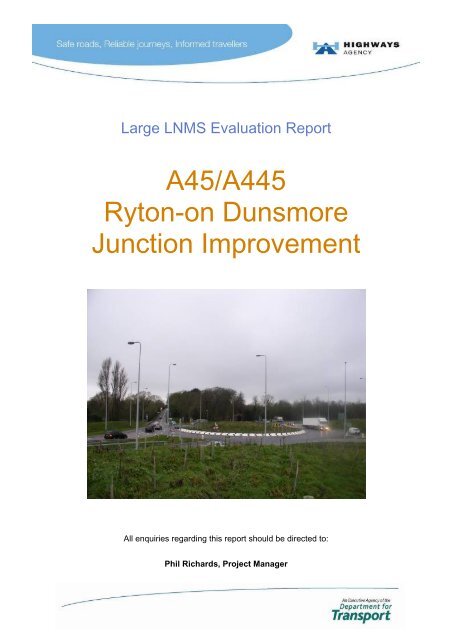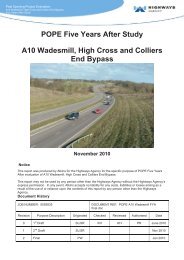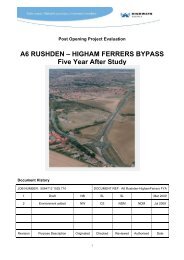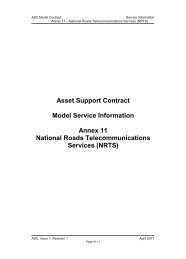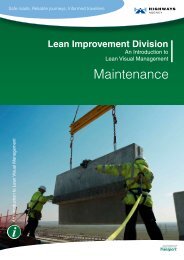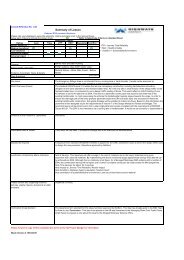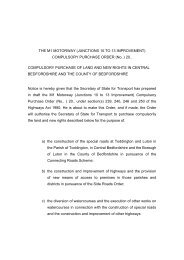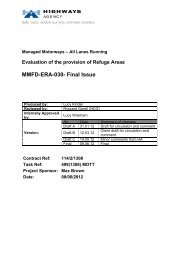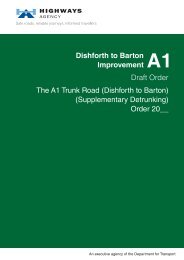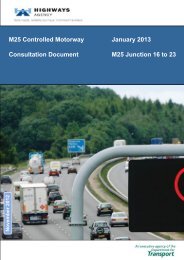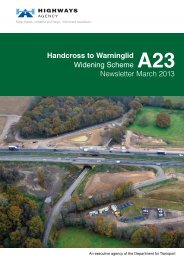A45/A445 Ryton-on Dunsmore Junction ... - Highways Agency
A45/A445 Ryton-on Dunsmore Junction ... - Highways Agency
A45/A445 Ryton-on Dunsmore Junction ... - Highways Agency
You also want an ePaper? Increase the reach of your titles
YUMPU automatically turns print PDFs into web optimized ePapers that Google loves.
Large LNMS Evaluati<strong>on</strong> Report<str<strong>on</strong>g>A45</str<strong>on</strong>g>/<str<strong>on</strong>g>A445</str<strong>on</strong>g><str<strong>on</strong>g>Ryt<strong>on</strong></str<strong>on</strong>g>-<strong>on</strong> <strong>Dunsmore</strong>Juncti<strong>on</strong> ImprovementAll enquiries regarding this report should be directed to:Phil Richards, Project Manager
Large LNMS Evaluati<strong>on</strong> Report<str<strong>on</strong>g>A45</str<strong>on</strong>g>/<str<strong>on</strong>g>A445</str<strong>on</strong>g><str<strong>on</strong>g>Ryt<strong>on</strong></str<strong>on</strong>g>-<strong>on</strong> <strong>Dunsmore</strong>Juncti<strong>on</strong> ImprovementFebruary 2008JOB NUMBER: 5048001.804DOCUMENT REF: Final Report to HARevisi<strong>on</strong> Purpose / Descripti<strong>on</strong> Originated Checked Reviewed Authorised DateA Draft Final Report JS CS NDM/JS NDM 01/02/08B Final Report JS NDM JS NDM 10/04/08Originated Checked Reviewed Authorised DateATKINS CONSULTANTS LTDThe AXIS, 10 Holliday Street, Birmingham, B1 1TFTel 0121 483 5000, Fax 0121 483 6161
Large LNMS Evaluati<strong>on</strong> Report<str<strong>on</strong>g>A45</str<strong>on</strong>g>/<str<strong>on</strong>g>A445</str<strong>on</strong>g> <str<strong>on</strong>g>Ryt<strong>on</strong></str<strong>on</strong>g>-<strong>on</strong>-<strong>Dunsmore</strong> Juncti<strong>on</strong> Improvements SchemeC<strong>on</strong>tentsSecti<strong>on</strong>Page1. Introducti<strong>on</strong> 1-12. Data Collecti<strong>on</strong> and Stakeholder Feedback 2-13. Traffic and Ec<strong>on</strong>omic Impacts 3-1Summary of Costs 3-114. Safety Impacts 4-1Introducti<strong>on</strong> 4-1The Par Assessment 4-1Speed Camera Impacts 4-2Juncti<strong>on</strong> Improvement Impacts 4-2Accident Locati<strong>on</strong> Analysis 4-3Accident Severity Analysis 4-35. Envir<strong>on</strong>mental, Accessibility and Integrati<strong>on</strong> Impacts 5-1Introducti<strong>on</strong> 5-1envir<strong>on</strong>ment 5-1Integrati<strong>on</strong> 5-26. Summary of Findings and Recommendati<strong>on</strong>s 6-1List of TablesTable 3.1 - Annual Average Daily Traffic (AADT) and NRTF Growth Forecasts 3-3Table 3.2 – Total Peak Hour Flow (Turning Count Data) 3-4Table 3.3 – Summary of predicted Journey Time Benefits (as per the PAR) 3-7Table 3.4 – Summary of predicted corrected Journey Time benefits 3-8Table 3.5 - <str<strong>on</strong>g>A45</str<strong>on</strong>g> Pre- and Post-Opening <str<strong>on</strong>g>A45</str<strong>on</strong>g> Journey Times 3-9Table 3.6 – Summary of Outturn Ec<strong>on</strong>omic Benefits 3-10Table 3.7 – Summary of Outturn <str<strong>on</strong>g>A45</str<strong>on</strong>g> Off-Peak Disbenefits 3-11Table 3.8 – The predicted, predicted corrected and outturn costs for the scheme 3-11Table 4.1 – Accident Analysis 4-3Table 4.2 – Accident Severity Analysis 4-4Table 4.3 - Accident Causati<strong>on</strong> Analysis 4-1Table 4.4 – Predicted and outturn m<strong>on</strong>etary safety benefits 4-1Table 7.1 – Summary of scheme benefits (predicted, predicted corrected and outturn) 6-120080307_POPE LNMS_<str<strong>on</strong>g>A45</str<strong>on</strong>g>-<str<strong>on</strong>g>A445</str<strong>on</strong>g> <str<strong>on</strong>g>Ryt<strong>on</strong></str<strong>on</strong>g> <strong>on</strong> <strong>Dunsmore</strong> report_Final.doci
Large LNMS Evaluati<strong>on</strong> Report<str<strong>on</strong>g>A45</str<strong>on</strong>g>/<str<strong>on</strong>g>A445</str<strong>on</strong>g> <str<strong>on</strong>g>Ryt<strong>on</strong></str<strong>on</strong>g>-<strong>on</strong>-<strong>Dunsmore</strong> Juncti<strong>on</strong> Improvements SchemeList of FiguresFigure 1.1 – <str<strong>on</strong>g>A45</str<strong>on</strong>g>/<str<strong>on</strong>g>A445</str<strong>on</strong>g> Juncti<strong>on</strong> Locati<strong>on</strong> 1-1Figure 1.2 – Before and After Juncti<strong>on</strong> Layout 1-1Figure 2.1 – Photographs illustrating traffic flow during site visit (6 th February 2007, AMpeak) 2-1Figure 3.1 - HA Traffic Count Permanent Site Locati<strong>on</strong> 3-3Figure 3.2 – A Comparis<strong>on</strong> of Before and After Daily Traffic Profile 3-4Figure 5.1 – Envir<strong>on</strong>mental and Accessibility Mitigati<strong>on</strong> Measure 5-120080307_POPE LNMS_<str<strong>on</strong>g>A45</str<strong>on</strong>g>-<str<strong>on</strong>g>A445</str<strong>on</strong>g> <str<strong>on</strong>g>Ryt<strong>on</strong></str<strong>on</strong>g> <strong>on</strong> <strong>Dunsmore</strong> report_Final.docii
Large LNMS Evaluati<strong>on</strong> Report<str<strong>on</strong>g>A45</str<strong>on</strong>g>/<str<strong>on</strong>g>A445</str<strong>on</strong>g> <str<strong>on</strong>g>Ryt<strong>on</strong></str<strong>on</strong>g>-<strong>on</strong>-<strong>Dunsmore</strong> Juncti<strong>on</strong> Improvements SchemeGlossaryThe following table details the acr<strong>on</strong>yms and specialist terms used within the c<strong>on</strong>text of thisreport.TermDefiniti<strong>on</strong>AADTAccessibilityAMASTATCDfTDiscountingDo MinimumDo SomethingGeometric DelayHGV<strong>Highways</strong> <strong>Agency</strong>IPKSILight vehicleManaging AgentAnnual Average Daily Traffic. Average of 24 hour flows, seven days aweek, for all days within the year.Accessibility can be defined as ‘ease of reaching’. The accessibilityobjective is c<strong>on</strong>cerned with increasing the ability with which people indifferent locati<strong>on</strong>s, and with differing availability of transport, can reachdifferent types of facility.Denoting the morning peak period.Appraisal Summary Table. This records the impacts of the schemeaccording to the Government’s five key objects for transport, as defined inDfT guidance c<strong>on</strong>tained <strong>on</strong> its Transport Analysis Guidance web pages,WebTAG.Automatic Traffic Count, a machine which measures traffic flow at a point inthe road.Department for Transport.Discounting is a technique used to compare costs and benefits that occurin different time periods and is the process of adjusting future cash flows totheir present values to reflect the time value of m<strong>on</strong>ey, e.g. £1 worth ofbenefits now is worth more than £1 in the future. A standard base yearneeds to be used which is 2002 for the appraisal used in this report.A scenario that represents the outturn situati<strong>on</strong> if no scheme were to beimplemented.A scenario that represents the outturn situati<strong>on</strong> given implementati<strong>on</strong> of thescheme.The delay caused to traffic as a result of the road layout.Heavy Goods Vehicle.An Executive <strong>Agency</strong> of the Department for Transport, resp<strong>on</strong>sible foroperating, maintaining and improving the strategic road network inEngland.Inter Peak, the time between the AM and PM peaks.Killed or Seriously Injured.Not a HGV. For traffic flow data, it is a vehicle less than 5.2m in length.A Managing Agent is resp<strong>on</strong>sible for the operati<strong>on</strong>, maintenance, andimprovement of the motorway and trunk road network of a <strong>Highways</strong><strong>Agency</strong> area.1-1
Large LNMS Evaluati<strong>on</strong> Report<str<strong>on</strong>g>A45</str<strong>on</strong>g>/<str<strong>on</strong>g>A445</str<strong>on</strong>g> <str<strong>on</strong>g>Ryt<strong>on</strong></str<strong>on</strong>g>-<strong>on</strong>-<strong>Dunsmore</strong> Juncti<strong>on</strong> Improvements SchemeMTCNRTFPARPIAPMPOPERPIManual turning count. A survey of the turning movements of vehicles at ajuncti<strong>on</strong> undertaken my human observers, normally <strong>on</strong> a single day.Nati<strong>on</strong>al Road Traffic Forecast. This document defines the latest forecastsproduced by the Department of the Envir<strong>on</strong>ment, Transport and theRegi<strong>on</strong>s of the growth in the volume of motor traffic. The most recent <strong>on</strong>eis NRTF97 and the <strong>on</strong>e previous was NRTF89.Project Appraisal Report These are undertaken for <strong>Highways</strong> <strong>Agency</strong>improvement schemes which are not TPI's.Pers<strong>on</strong>al Injury Accident. A road traffic accident in which at least <strong>on</strong>epers<strong>on</strong> required medical treatment.Evening peak period.Post Opening Project Evaluati<strong>on</strong>, before & after m<strong>on</strong>itoring of all majorhighway schemes in England.Retail Price Index – the most familiar general purpose domestic measure ofinflati<strong>on</strong> in the United Kingdom.RPFRetail Price Factor - Adjustment factor for RPI.SeveranceSTATS19TRADSVehicle hoursCommunity severance is the separati<strong>on</strong> of adjacent areas by road or heavytraffic, causing negative impact <strong>on</strong> n<strong>on</strong>-motorised users, particularlypedestrians.A database of injury accident statistics recorded by police officers attendingaccidents.The TRADS system provides access to traffic flow informati<strong>on</strong> collectedfrom England’s motorway and major trunk road network.Vehicle hours refers to the total time spent by all vehicles using a road andis expressed normally as a yearly value. For example, if 10,000 vehicles aday used a route with a 6 minute journey time, then the route’s vehiclehours for the year would be 365,000.1-2
Large LNMS Evaluati<strong>on</strong> Report<str<strong>on</strong>g>A45</str<strong>on</strong>g>/<str<strong>on</strong>g>A445</str<strong>on</strong>g> <str<strong>on</strong>g>Ryt<strong>on</strong></str<strong>on</strong>g>-<strong>on</strong>-<strong>Dunsmore</strong> Juncti<strong>on</strong> Improvements Scheme1. Introducti<strong>on</strong>BACKGROUND1.1 The juncti<strong>on</strong> of the <str<strong>on</strong>g>A45</str<strong>on</strong>g>, <str<strong>on</strong>g>A445</str<strong>on</strong>g> and B4029 lies within Area 11 near the village of<str<strong>on</strong>g>Ryt<strong>on</strong></str<strong>on</strong>g>-<strong>on</strong>-<strong>Dunsmore</strong>, south of Coventry in Warwickshire (Figure 1.1).Figure 1.1 – <str<strong>on</strong>g>A45</str<strong>on</strong>g>/<str<strong>on</strong>g>A445</str<strong>on</strong>g> Juncti<strong>on</strong> Locati<strong>on</strong>1.2 Prior to scheme opening, the juncti<strong>on</strong> was arranged as a staggered crossroads. The<str<strong>on</strong>g>A45</str<strong>on</strong>g> traffic had priority with the <str<strong>on</strong>g>A445</str<strong>on</strong>g> and B4029 utilising gaps in the centralreservati<strong>on</strong> for straight ahead and right-turn movements (See Figure 1.2).1.3 The former juncti<strong>on</strong> layout had a poor safety record for many years with 4 fatal, 7serious and 20 slight accidents (between 1999 and 2004). The majority of theseaccidents occurred as a result of c<strong>on</strong>flicting movements between turning side roadtraffic and through traffic <strong>on</strong> the <str<strong>on</strong>g>A45</str<strong>on</strong>g>. Speed cameras were installed al<strong>on</strong>g the <str<strong>on</strong>g>A45</str<strong>on</strong>g> inApril 2001 in an effort to reduce accidents at the juncti<strong>on</strong>. However, following theintroducti<strong>on</strong> of the speed cameras, safety c<strong>on</strong>cerns at the juncti<strong>on</strong> remained.SCHEME DESCRIPTION1.4 The scheme opened in August 2005 and included:♦Replacement of the existing staggered layout with a four arm roundabout;1-1
Large LNMS Evaluati<strong>on</strong> Report<str<strong>on</strong>g>A45</str<strong>on</strong>g>/<str<strong>on</strong>g>A445</str<strong>on</strong>g> <str<strong>on</strong>g>Ryt<strong>on</strong></str<strong>on</strong>g>-<strong>on</strong>-<strong>Dunsmore</strong> Juncti<strong>on</strong> Improvements Scheme♦♦Realignment of the B4029 Wolst<strong>on</strong> Lane to approach the juncti<strong>on</strong> opposite the<str<strong>on</strong>g>A445</str<strong>on</strong>g> approach and the old secti<strong>on</strong> of the B4029 closed off; andClosure of the central reservati<strong>on</strong> gaps.SCHEME CATEGORISATION AND OBJECTIVES1.5 Local Network Management Schemes (LNMS) are categorised according to which ofthe five assessment objectives of safety, ec<strong>on</strong>omy, envir<strong>on</strong>ment, accessibility andintegrati<strong>on</strong> is primarily addressed by the scheme. As detailed in the PAR document,the scheme objectives were:♦♦To reduce the number of accidents at the juncti<strong>on</strong> by removing the need forvehicles to cross the <str<strong>on</strong>g>A45</str<strong>on</strong>g> via the gap; andTo reduce the speed of <str<strong>on</strong>g>A45</str<strong>on</strong>g> traffic in order to negotiate the juncti<strong>on</strong>.1.6 The scheme has therefore been categorised as a safety scheme.PURPOSE OF THIS REPORT1.7 As part of an <strong>on</strong>going requirement of the <strong>Highways</strong> <strong>Agency</strong> to re-evaluate the impactsof new trunk road schemes, Atkins C<strong>on</strong>sultants Ltd has been commissi<strong>on</strong>ed by the<strong>Highways</strong> <strong>Agency</strong> to undertake post-opening evaluati<strong>on</strong>s of Local NetworkManagement Schemes (LNMS) with an implementati<strong>on</strong> cost of between £1m and£5m. The aim of this process is to assist the <strong>Highways</strong> <strong>Agency</strong> (HA) and theirManaging Agents to:♦♦♦Quantify the outturn benefits and disbenefits accruing from new schemes and toascertain which schemes offer the greatest value for m<strong>on</strong>ey;Develop the pre-scheme appraisal processes (PAR Guidance) and ensure thataccurate predicti<strong>on</strong>s are made about the possible impacts of highway schemes<strong>on</strong> safety, ec<strong>on</strong>omy, envir<strong>on</strong>ment, accessibility and integrati<strong>on</strong> in the future; andEnsure that the HA c<strong>on</strong>tinues to deliver schemes that offer the greatest value form<strong>on</strong>ey and that are most effective soluti<strong>on</strong>s to problems <strong>on</strong> the core network.1.8 This document specifically sets out the results of the Post-opening Project Evaluati<strong>on</strong>(POPE) of the <str<strong>on</strong>g>A45</str<strong>on</strong>g>/<str<strong>on</strong>g>A445</str<strong>on</strong>g> <str<strong>on</strong>g>Ryt<strong>on</strong></str<strong>on</strong>g>-<strong>on</strong>-<strong>Dunsmore</strong> Juncti<strong>on</strong> Improvement Scheme asimplemented in August 2005. More specifically, the report examines the ec<strong>on</strong>omic,safety, envir<strong>on</strong>mental, accessibility, and integrati<strong>on</strong> impacts resulting from scheme.POPE METHODOLOGY OVERVIEW1.9 This report initially presents an assessment of the physical impacts of the schemeand more specifically:♦ A comparis<strong>on</strong> of the ‘before’ and ‘after’ traffic volumes at the juncti<strong>on</strong> to illustratehow overall traffic c<strong>on</strong>diti<strong>on</strong>s have changed following scheme opening; and♦ An outline of changes in accident rates at the juncti<strong>on</strong> following scheme opening.1.10 This is then followed by an assessment of the scheme in accordance with the POPEmethodology. This methodology aims to provide a method by which forecast andoutturn effects of a scheme can be compared <strong>on</strong> a comm<strong>on</strong> basis. This processultimately derives the following:1-2
Large LNMS Evaluati<strong>on</strong> Report<str<strong>on</strong>g>A45</str<strong>on</strong>g>/<str<strong>on</strong>g>A445</str<strong>on</strong>g> <str<strong>on</strong>g>Ryt<strong>on</strong></str<strong>on</strong>g>-<strong>on</strong>-<strong>Dunsmore</strong> Juncti<strong>on</strong> Improvements Scheme♦♦The original PAR assessment (completed by Optima in March 2004). Thisrepresents the forecast benefits of the scheme; andAn Evaluati<strong>on</strong> Summary Table based <strong>on</strong> the outturn effects of the scheme usinga methodology c<strong>on</strong>sistent with the original PAR assessment undertaken prior toscheme opening.REPORT STRUCTURE1.11 This report has been divided into 5 further secti<strong>on</strong>s as follows:♦♦♦♦♦Chapter 2: Data Collecti<strong>on</strong> and Stakeholder Feedback;Chapter 3: Traffic and Ec<strong>on</strong>omic Impacts;Chapter 4: Safety Impacts;Chapter 5: Envir<strong>on</strong>mental, Accessibility and Integrati<strong>on</strong> Impacts; andChapter 6: Summary of Findings and Recommendati<strong>on</strong>s.1.12 It is intended that the findings from this report will feed into a wider summary of theoutcomes of the POPE process as reported in the LNMS Annual Evaluati<strong>on</strong> report.1-3
Large LNMS Evaluati<strong>on</strong> Report<str<strong>on</strong>g>A45</str<strong>on</strong>g>/<str<strong>on</strong>g>A445</str<strong>on</strong>g> <str<strong>on</strong>g>Ryt<strong>on</strong></str<strong>on</strong>g>-<strong>on</strong>-<strong>Dunsmore</strong> Juncti<strong>on</strong> Improvements Scheme<str<strong>on</strong>g>A445</str<strong>on</strong>g><str<strong>on</strong>g>A45</str<strong>on</strong>g>A44A4B402B4029BeforeAfterFigure 1.2 – Before and After Juncti<strong>on</strong> Layout1-1
Large LNMS Evaluati<strong>on</strong> Report<str<strong>on</strong>g>A45</str<strong>on</strong>g>/<str<strong>on</strong>g>A445</str<strong>on</strong>g> <str<strong>on</strong>g>Ryt<strong>on</strong></str<strong>on</strong>g>-<strong>on</strong>-<strong>Dunsmore</strong> Juncti<strong>on</strong> Improvements Scheme2. Data Collecti<strong>on</strong> and Stakeholder FeedbackINTRODUCTION2.1 This chapter sets out the data collecti<strong>on</strong> process used to support this schemeevaluati<strong>on</strong>. More specifically this chapter:♦ Lists the datasets used to undertake the scheme POPE assessment;♦ Summarises the outcomes of a site visit undertaken by Atkins in January 2007;and♦ Provides a summary of the feedback from various stakeholders regarding theoverall effectiveness of the scheme in achieving the intended objectives.DATASETS USED TO SUPPORT THE POPE EVALUATION2.2 A number of data sets were used to inform this POPE study, these are listed asfollows:Pre-Scheme Opening Data♦♦♦♦♦PICADY and ARCADY modelling files used to determine the predicted schemeimpacts <strong>on</strong> juncti<strong>on</strong> delay as calculated in the PAR assessment;<strong>Highways</strong> <strong>Agency</strong> TRADS 2 Database ATC data, from permanent count sites11/9641 (eastbound) and 11/9642 (westbound) <strong>on</strong> the <str<strong>on</strong>g>A45</str<strong>on</strong>g> between 2001 and2004;Full peak hour turning count survey for <str<strong>on</strong>g>A45</str<strong>on</strong>g>/<str<strong>on</strong>g>A445</str<strong>on</strong>g> juncti<strong>on</strong> during the AM peak(07:45 – 08:45) and PM peak (17:00 – 18:00), undertaken <strong>on</strong> 16th January2001,Pers<strong>on</strong>al Injury Accident (PIA) data for the period between January 1999 andDecember 2004; andRelevant data to support the assessment of the possible scheme impacts <strong>on</strong>Envir<strong>on</strong>ment, Accessibility and Integrati<strong>on</strong>.Post-Scheme Opening Data♦♦<strong>Highways</strong> <strong>Agency</strong> TRADS 2 Database ATC data, from permanent count sites11/9641 (eastbound) and 11/9642 (westbound) <strong>on</strong> the <str<strong>on</strong>g>A45</str<strong>on</strong>g> between 2006 and2007;Full peak hour turning count survey for <str<strong>on</strong>g>A45</str<strong>on</strong>g>/<str<strong>on</strong>g>A445</str<strong>on</strong>g> juncti<strong>on</strong> during the AM peak(07:45 – 08:45) and PM peak (17:00 – 18:00), undertaken <strong>on</strong> Tuesday 27thFebruary 2007;♦ Journey time survey results undertaken over a 1.2km secti<strong>on</strong> of the <str<strong>on</strong>g>A45</str<strong>on</strong>g>including the juncti<strong>on</strong> , during March 2007; and♦ Pers<strong>on</strong>al Injury Accident (PIA) data for the 15 m<strong>on</strong>th period October 2004 –December 2005.Other Data♦ AM peak hour site observati<strong>on</strong>s as c<strong>on</strong>ducted by Atkins in January 2007;2-1
Large LNMS Evaluati<strong>on</strong> Report<str<strong>on</strong>g>A45</str<strong>on</strong>g>/<str<strong>on</strong>g>A445</str<strong>on</strong>g> <str<strong>on</strong>g>Ryt<strong>on</strong></str<strong>on</strong>g>-<strong>on</strong>-<strong>Dunsmore</strong> Juncti<strong>on</strong> Improvements Scheme♦♦♦♦C<strong>on</strong>sultati<strong>on</strong> with the MAC (Optima);C<strong>on</strong>sultati<strong>on</strong> with the Project Sp<strong>on</strong>sor;C<strong>on</strong>sultati<strong>on</strong> with Warwickshire County Council Officers; andC<strong>on</strong>sultati<strong>on</strong> with Warwickshire Cycle Touring Club.SUMMARY OF SITE OBSERVATIONS2.3 A site visit was c<strong>on</strong>ducted in January 2007 to observe post-opening traffic c<strong>on</strong>diti<strong>on</strong>sat the juncti<strong>on</strong> during the AM peak period. The objectives of the site visit were asfollows:♦♦♦To ensure that the scheme was implemented as per the original PAR andscheme drawings provided by the MAC.To observe the post-opening juncti<strong>on</strong> operating c<strong>on</strong>diti<strong>on</strong>s during the AM peakperiod, with regard to traffic flow and safety; andTo provide an assessment of whether envir<strong>on</strong>mental mitigati<strong>on</strong> measures hadbeen implemented as detailed in the PAR.2.4 Post-opening traffic c<strong>on</strong>diti<strong>on</strong>s as at the site are illustrated in Figure 2.1. Thefollowing observati<strong>on</strong>s were made during the site visit (envir<strong>on</strong>mental, integrati<strong>on</strong> andaccessibility site observati<strong>on</strong>s are dealt with later in the report):♦♦♦♦♦♦All elements of the scheme appeared to have been completed as described inthe PAR document and the scheme drawings;Despite the delay imposed by the roundabout to the mainline <str<strong>on</strong>g>A45</str<strong>on</strong>g> traffic, thetraffic appeared to be moving well with little queuing <strong>on</strong> these arms;Some misuse of the left turn lane from <str<strong>on</strong>g>A45</str<strong>on</strong>g> south-east approach by vehiclestravelling straight <strong>on</strong> was observed;Some queuing was noted <strong>on</strong> the B4029 (observed to be up to 11 cars at <strong>on</strong>epoint during the AM peak), however, the roundabout allowed the queue to movequickly. The speed of the <str<strong>on</strong>g>A45</str<strong>on</strong>g> traffic travelling through the roundabout required aquick resp<strong>on</strong>se from drivers entering from the Wolst<strong>on</strong> Lane approach. A nearmiss was observed when a vehicle pulled out of Wolst<strong>on</strong> Lane and c<strong>on</strong>flictedwith a vehicle travelling <strong>on</strong> the <str<strong>on</strong>g>A45</str<strong>on</strong>g>;Some queuing was also noted <strong>on</strong> the <str<strong>on</strong>g>A445</str<strong>on</strong>g> approach to the juncti<strong>on</strong> (6 carswere noted to be queuing at <strong>on</strong>e point during the AM Peak period) but again thisqueue cleared quickly; andTraffic c<strong>on</strong>diti<strong>on</strong>s <strong>on</strong> the circulating carriageway were free flow; however poorlane discipline was observed.STAKEHOLDER FEEDBACK2.5 The following points of interest emerged from a discussi<strong>on</strong> with the MAC regardingthe relative successes and shortcomings of the scheme:♦The scheme has met its main objective to improve safety as no major accidentshave occurred at the juncti<strong>on</strong> following the latest improvements; and2-2
Large LNMS Evaluati<strong>on</strong> Report<str<strong>on</strong>g>A45</str<strong>on</strong>g>/<str<strong>on</strong>g>A445</str<strong>on</strong>g> <str<strong>on</strong>g>Ryt<strong>on</strong></str<strong>on</strong>g>-<strong>on</strong>-<strong>Dunsmore</strong> Juncti<strong>on</strong> Improvements Scheme♦The <strong>on</strong>ly issue of c<strong>on</strong>cern was <strong>on</strong>e identified by the Safety Audit and is related tothe lane alignments at the roundabout. This is likely be the reas<strong>on</strong> for the misuseof the left-<strong>on</strong>ly lane <strong>on</strong> the <str<strong>on</strong>g>A45</str<strong>on</strong>g> East observed <strong>on</strong> the site visit. This wasidentified as a minor issue <strong>on</strong>ly and is currently being investigated.2.6 Discussi<strong>on</strong>s with the <strong>Highways</strong> <strong>Agency</strong> Project Sp<strong>on</strong>sor highlighted that the he wasparticularly happy with how the juncti<strong>on</strong> improvements have performed. Particularcomments were:♦♦The implementati<strong>on</strong> of the roundabout has helped to reduce speeds as well asprevented the need for the central reserve gaps. This has made a hugec<strong>on</strong>tributi<strong>on</strong> to safety improvements; andOperati<strong>on</strong>ally, the juncti<strong>on</strong> also works very well.2.7 Warwickshire County Council provided the following feedback:♦♦♦♦The c<strong>on</strong>structi<strong>on</strong> of the juncti<strong>on</strong> improvements appears to have been very wellexecuted and there have been no operati<strong>on</strong>al issues since its completi<strong>on</strong>;The road gullies <strong>on</strong> the approach to the island from the <str<strong>on</strong>g>A445</str<strong>on</strong>g> approach have notbeen c<strong>on</strong>nected to a suitable drainage system;Insufficient c<strong>on</strong>siderati<strong>on</strong> was given to the speed cameras close to the site priorto the c<strong>on</strong>structi<strong>on</strong> of the roundabout, making it difficult for the WarwickshireCasualty Reducti<strong>on</strong> Partnership to install temporary speed cameras in place ofthose cameras affected by the works; andOn completi<strong>on</strong> of the roundabout it was found that the building of the roundabouthad affected the existing Traffic Regulati<strong>on</strong> Order which governed the speedenforcement at the locati<strong>on</strong> and that variati<strong>on</strong>s to that order were required beforeenforcement could resume. This rendered the cameras unusable for over 12m<strong>on</strong>ths. This was felt to be unacceptable but Warwickshire Police had no opti<strong>on</strong>but to await the variati<strong>on</strong> order.2.8 C<strong>on</strong>sultati<strong>on</strong> with Warwickshire Cycle Touring Club suggested that:♦♦Vehicle speeds both <strong>on</strong> the roundabout and approaching the juncti<strong>on</strong> areintimidating for cyclists using the roundabout.; andThe cycle path is inadequate and poorly placed. No further explanati<strong>on</strong> wasprovided.2-3
Large LNMS Evaluati<strong>on</strong> Report<str<strong>on</strong>g>A45</str<strong>on</strong>g>/<str<strong>on</strong>g>A445</str<strong>on</strong>g> <str<strong>on</strong>g>Ryt<strong>on</strong></str<strong>on</strong>g>-<strong>on</strong>-<strong>Dunsmore</strong> Juncti<strong>on</strong> Improvements SchemeSECTION SUMMARY♦♦♦♦♦♦♦♦The scheme appears to be implemented as detailed in the original PAR andscheme drawings;Site observati<strong>on</strong>s illustrate that there is little delay during the AM peak otherthan a small amount of geometric delay introduced for mainline traffic at thejuncti<strong>on</strong>;From site observati<strong>on</strong>s, there is some delay for the B4029 and <str<strong>on</strong>g>A445</str<strong>on</strong>g> traffic,however this appears to be much less than those of the previous layout asdescribed in the PAR (pre-opening delays of 9 minutes);There is evidence that traffic entering the roundabout from the B4029approach finds it difficult to enter the circulating carriageway due to the speedof traffic approaching from the <str<strong>on</strong>g>A45</str<strong>on</strong>g>;There is some misuse of the left-turn lane from the <str<strong>on</strong>g>A45</str<strong>on</strong>g> westbound approachwhich resulted in an observed near-miss;Insufficient c<strong>on</strong>siderati<strong>on</strong> was given to the speed cameras and related TrafficRegulati<strong>on</strong> Orders prior to the c<strong>on</strong>structi<strong>on</strong> of the scheme;Generally, stakeholder feedback has been positive and the improvements areperceived to be working well in terms of safety and operati<strong>on</strong>ally; andThe Cycle Touring Club highlighted some negative issues, relating to speedsat the juncti<strong>on</strong> and the adequacy and locati<strong>on</strong> of the cycle paths.2-4
Large LNMS Evaluati<strong>on</strong> Report<str<strong>on</strong>g>A45</str<strong>on</strong>g>/<str<strong>on</strong>g>A445</str<strong>on</strong>g> <str<strong>on</strong>g>Ryt<strong>on</strong></str<strong>on</strong>g>-<strong>on</strong>-<strong>Dunsmore</strong> Juncti<strong>on</strong> Improvements SchemeFigure 2.1 – Photographs illustrating traffic flow during site visit (6 th February 2007, AM peak)Circulating TrafficB4029 Approach<str<strong>on</strong>g>A445</str<strong>on</strong>g> Approach<str<strong>on</strong>g>A45</str<strong>on</strong>g> SE Approach2-1
Large LNMS Evaluati<strong>on</strong> Report<str<strong>on</strong>g>A45</str<strong>on</strong>g>/<str<strong>on</strong>g>A445</str<strong>on</strong>g> <str<strong>on</strong>g>Ryt<strong>on</strong></str<strong>on</strong>g>-<strong>on</strong>-<strong>Dunsmore</strong> Juncti<strong>on</strong> Improvements Scheme3. Traffic and Ec<strong>on</strong>omic ImpactsINTRODUCTION3.1 Although the primary objective of the scheme was to improve safety at the juncti<strong>on</strong>,the PAR identified that there would be some negative impacts <strong>on</strong> journey times (forthrough traffic) following scheme opening. This chapter sets out a post openingevaluati<strong>on</strong> of the ec<strong>on</strong>omic impacts emerging from the scheme. More specificallythis chapter will:♦♦♦Provide an appreciati<strong>on</strong> of recent changes in traffic volume and patterns at thejuncti<strong>on</strong>;Quantify the outturn impacts of the scheme <strong>on</strong> journey times in order to providean assessment of the ec<strong>on</strong>omic benefit of the scheme; andProvide an analysis of the outturn costs and compare them with those predictedin the original PAR assessment.TRAFFIC GROWTH TRENDS3.2 It is important to c<strong>on</strong>sider the extent to which traffic volumes have changed at thejuncti<strong>on</strong> before and after the improvements. Such an analysis serves two mainpurposes:♦♦To ascertain whether any additi<strong>on</strong>al traffic (induced traffic) has been attracted tothe juncti<strong>on</strong> as a result of the scheme; andTo ensure that the benefits for additi<strong>on</strong>al/new users of the juncti<strong>on</strong> arec<strong>on</strong>sidered in the estimati<strong>on</strong> of outturn ec<strong>on</strong>omic benefits.Annual Average Daily Traffic (<str<strong>on</strong>g>A45</str<strong>on</strong>g>)3.3 Annual Average Daily Traffic (AADT) data for a locati<strong>on</strong> east of the <str<strong>on</strong>g>A45</str<strong>on</strong>g>/<str<strong>on</strong>g>A445</str<strong>on</strong>g> <str<strong>on</strong>g>Ryt<strong>on</strong></str<strong>on</strong>g><strong>on</strong>-<strong>Dunsmore</strong>Juncti<strong>on</strong> has been collected from the TRADS website for the period2001 – 2007. Figure 3.1 illustrates the locati<strong>on</strong> of the site in relati<strong>on</strong> to the juncti<strong>on</strong>.Table 3.1 illustrates the change in two way AADT over the period 2001-2007 andhelps provide an appreciati<strong>on</strong> of recent traffic growth patterns at the juncti<strong>on</strong>.3.4 The following trends can be noted from Table 3.1:♦♦♦The two way AADT east of the juncti<strong>on</strong> has increased by 3% between 2001 and2007, this is lower than the Nati<strong>on</strong>al Road Traffic Forecast (NRTF) of 10%growth over the same period. NRTF is a nati<strong>on</strong>al growth estimate not specific toany area of the country.Two way flows decreased to 4% below the 2001 baseline during the c<strong>on</strong>structi<strong>on</strong>year (2005), but traffic has been attracted back to the juncti<strong>on</strong> in subsequentyears;The average AADT <strong>on</strong> the <str<strong>on</strong>g>A45</str<strong>on</strong>g> for the period 2001-2004 (24,688) is comparableto that for the period 2006 to 2007 (24,717) indicating there has been no changein <str<strong>on</strong>g>A45</str<strong>on</strong>g> traffic following scheme opening; and3-1
Large LNMS Evaluati<strong>on</strong> Report<str<strong>on</strong>g>A45</str<strong>on</strong>g>/<str<strong>on</strong>g>A445</str<strong>on</strong>g> <str<strong>on</strong>g>Ryt<strong>on</strong></str<strong>on</strong>g>-<strong>on</strong>-<strong>Dunsmore</strong> Juncti<strong>on</strong> Improvements Scheme♦The closure of the <str<strong>on</strong>g>Ryt<strong>on</strong></str<strong>on</strong>g> <strong>on</strong> <strong>Dunsmore</strong> Car plant appears not to have resulted inreduced AADT flows at the <str<strong>on</strong>g>Ryt<strong>on</strong></str<strong>on</strong>g> <strong>on</strong> <strong>Dunsmore</strong> juncti<strong>on</strong>, however it may havehad an influence <strong>on</strong> total traffic flows at the juncti<strong>on</strong> during peak hours;3-2
Large LNMS Evaluati<strong>on</strong> Report<str<strong>on</strong>g>A45</str<strong>on</strong>g>/<str<strong>on</strong>g>A445</str<strong>on</strong>g> <str<strong>on</strong>g>Ryt<strong>on</strong></str<strong>on</strong>g>-<strong>on</strong>-<strong>Dunsmore</strong> Juncti<strong>on</strong> Improvements SchemeFigure 3.1 - HA Traffic Count Permanent Site Locati<strong>on</strong>HA PermanentCount Site© Crown Copyright. All rights reserved. <strong>Highways</strong> <strong>Agency</strong>: 100018928. 2007Table 3.1 - Annual Average Daily Traffic (AADT) and NRTF Growth ForecastsYearAnnual Average Daily Traffic (AADT)in vehiclesCumulativeGrowthNRTF 97ForecastGrowth2001 24,529 1.00 1.002002 24,645 1.00 1.022003 24,818 1.01 1.032004 24,761 1.01 1.052005 23,506 0.96 1.072006 24,242 0.99 1.092007 25,192 1.03 1.10Peak Hour Flow Changes3.5 Closer examinati<strong>on</strong> of the daily traffic profile before and after scheme openingillustrates there have been some subtle changes in <str<strong>on</strong>g>A45</str<strong>on</strong>g> traffic volumes followingscheme opening. Figure 3.2 provides a snapshot of the daily traffic profile for March2002 (Pre opening) and March 2007 (post opening).3-3
Large LNMS Evaluati<strong>on</strong> Report<str<strong>on</strong>g>A45</str<strong>on</strong>g>/<str<strong>on</strong>g>A445</str<strong>on</strong>g> <str<strong>on</strong>g>Ryt<strong>on</strong></str<strong>on</strong>g>-<strong>on</strong>-<strong>Dunsmore</strong> Juncti<strong>on</strong> Improvements SchemeFigure 3.2 – A Comparis<strong>on</strong> of Before and After Daily Traffic Profile35003000Number of Vehicles2500200015001000Mar-02Mar-075000Ending02:0004:0006:0008:0010:0012:0014:0016:0018:0020:0022:0024:00:00Hour EndingThe following can be noted from a comparis<strong>on</strong> between the two profiles:♦ There has been virtually no change in the distributi<strong>on</strong> of traffic flows across theday and no peak spreading as a result of the scheme;♦ There has been a very slight increase in inter-peak traffic (08:45-17:00) between2002 and 2007 (4.6%, an additi<strong>on</strong>al 598 vehicles); and♦ AM and PM peak periods, flows have changed very slightly with a decrease of-3% (88 vehicles) in the AM peak and of -4% (129 vehicles) in the PM peakperiod.Turning Count Analysis3.6 Full turning counts were undertaken in January 2001 (pre opening) and January2007 (post opening) for the AM (07:45-08:45) and PM (17:00-18:00) peak periodsrespectively. Table 3.2 provides a comparis<strong>on</strong> of observed total flow changes for2001 and 2007. Analysis of the turning count surveys reveal that the total AM andPM peak hour traffic at the juncti<strong>on</strong> (from all arms) has reduced by 5.3% and 2.1%respectively.Table 3.2 – Total Peak Hour Flow (Turning Count Data)Peak January 2001 January 2007 Change in TrafficVehicle Numbers(%)AM Peak 3621 3426 -195 (-5.3%)PM Peak 3057 2991 -66 (-2.1%)3-4
Large LNMS Evaluati<strong>on</strong> Report<str<strong>on</strong>g>A45</str<strong>on</strong>g>/<str<strong>on</strong>g>A445</str<strong>on</strong>g> <str<strong>on</strong>g>Ryt<strong>on</strong></str<strong>on</strong>g>-<strong>on</strong>-<strong>Dunsmore</strong> Juncti<strong>on</strong> Improvements Scheme3.7 Appendix A c<strong>on</strong>tains pre and post opening peak hour turning count diagrams. Thekey trends that can be identified from an examinati<strong>on</strong> of the pre and post openingturning count informati<strong>on</strong> are listed as follows:AM Peak Impacts♦♦♦♦♦♦The proporti<strong>on</strong> of turning movements originating from the side roads (Wolst<strong>on</strong>Lane and the <str<strong>on</strong>g>A445</str<strong>on</strong>g>) has increased from 9% (2001) to 20% (2007) – an increaseof 350 vehicles;The proporti<strong>on</strong> of all turning movements originating from the <str<strong>on</strong>g>A45</str<strong>on</strong>g> westboundapproach has decreased from 59% to 47% - a reducti<strong>on</strong> of 540 vehicles;The total number of right turning movements originating from the <str<strong>on</strong>g>A45</str<strong>on</strong>g> hasincreased by 1188% (from 25 to 322 movements);Through movements <strong>on</strong> the <str<strong>on</strong>g>A45</str<strong>on</strong>g> have decreased by 25% (685 less vehicles);andThrough movements across the <str<strong>on</strong>g>A45</str<strong>on</strong>g> have decreased by 42% (47 less vehicles);andThe number of HGV’s using the juncti<strong>on</strong> has reduced from 248 to168 (33%) inthe AM peak.PM Peak Impacts♦♦♦♦The proporti<strong>on</strong> of turning movements originating from the side roads (Wolst<strong>on</strong>Lane and the <str<strong>on</strong>g>A445</str<strong>on</strong>g>) has increased from 10% (2001) to 20% (2007) – anincrease of 288 vehicles;The proporti<strong>on</strong> of all turning movements originating from the <str<strong>on</strong>g>A45</str<strong>on</strong>g> eastboundapproach has decreased from 59% to 47% - a reducti<strong>on</strong> of 297 vehicles;The total number of right turning movements originating from the <str<strong>on</strong>g>A45</str<strong>on</strong>g> hasincreased by 952% (from 25 to 263 movements);Through movements <strong>on</strong> the <str<strong>on</strong>g>A45</str<strong>on</strong>g> have decreased by 23% (555 less vehicles);and♦ Through movements across the <str<strong>on</strong>g>A45</str<strong>on</strong>g> have decreased by 63% (71 less vehicles);and♦ The number of HGV’s using the juncti<strong>on</strong> has reduced from 157 to 95 (40%).Interpretati<strong>on</strong> of Traffic Impacts3.8 In the summary, the following c<strong>on</strong>clusi<strong>on</strong>s can be reached from the review of pre andpost opening traffic trends:♦♦Analysis of the AADT data for the <str<strong>on</strong>g>A45</str<strong>on</strong>g> shows that cumulative traffic growthbetween 2001 and 2007 was lower (3%) than that forecast by NRTF (10%);Both the turning count data collected in 2001 and 2007 and the daily classifieddata collected from the permanent sites in 2002 and 2007 show a slightdecrease in peak hour traffic flows at the juncti<strong>on</strong> following completi<strong>on</strong> of the3-5
Large LNMS Evaluati<strong>on</strong> Report<str<strong>on</strong>g>A45</str<strong>on</strong>g>/<str<strong>on</strong>g>A445</str<strong>on</strong>g> <str<strong>on</strong>g>Ryt<strong>on</strong></str<strong>on</strong>g>-<strong>on</strong>-<strong>Dunsmore</strong> Juncti<strong>on</strong> Improvements Scheme♦♦♦♦♦scheme (2% to 5%). The closure of the <str<strong>on</strong>g>Ryt<strong>on</strong></str<strong>on</strong>g> car plant in December 2006appears to have had dramatic influence <strong>on</strong> total traffic flows at the juncti<strong>on</strong>during peak hours;HGV movements have also dramatically reduced at the juncti<strong>on</strong>, again this islikely to be a c<strong>on</strong>sequence of the <str<strong>on</strong>g>Ryt<strong>on</strong></str<strong>on</strong>g> car plant closure and not a result ofgeometric changes to the juncti<strong>on</strong> layout ;Inter-peak traffic data for the <str<strong>on</strong>g>A45</str<strong>on</strong>g> suggests that the geometric delay introducedby the installati<strong>on</strong> of new juncti<strong>on</strong> has not c<strong>on</strong>tributed towards a decrease in theusage of the juncti<strong>on</strong>;Potential re-development of the <str<strong>on</strong>g>Ryt<strong>on</strong></str<strong>on</strong>g> <strong>on</strong> <strong>Dunsmore</strong> is likely to have an impact<strong>on</strong> future traffic growth at the juncti<strong>on</strong>;The new juncti<strong>on</strong> layout appears to have attracted new trips to the juncti<strong>on</strong> fromthe <str<strong>on</strong>g>A445</str<strong>on</strong>g> and Wolst<strong>on</strong> Lane approaches (particularly for left-turning movementsand right-turning movements). The roundabout appears to have createdc<strong>on</strong>diti<strong>on</strong>s that favour side road movements given that the speed of throughtraffic <strong>on</strong> the <str<strong>on</strong>g>A45</str<strong>on</strong>g> has been much reduced; andThe juncti<strong>on</strong> improvements have also facilitated right movements from the <str<strong>on</strong>g>A45</str<strong>on</strong>g> inboth directi<strong>on</strong>s by creating better c<strong>on</strong>diti<strong>on</strong>s to turn.POPE ASSESSMENTThe PAR Appraisal3.9 The original PAR assessment for the <str<strong>on</strong>g>A45</str<strong>on</strong>g>/<str<strong>on</strong>g>A445</str<strong>on</strong>g> juncti<strong>on</strong> improvements wasundertaken by Optima Infrastructure Management. The PICADY and ARCADYmodelling software were used to estimate the journey time benefits that would resultfrom the scheme in the opening year. The PAR made the following assumpti<strong>on</strong>s forforecasting the ec<strong>on</strong>omic impacts of the scheme:♦First year and 30 year impacts were calculated for all time periods (AM, PM,Weekends, Nights and Daytime Inter peak);♦ The ec<strong>on</strong>omic modelling programme JUICE was used to calculate the openingyear and 30 year m<strong>on</strong>etary benefits of the scheme;♦ Traffic was assumed to grow according to the NRTF (central growth of 7%);♦♦Delays <strong>on</strong> the side roads before scheme opening during the AM were in theregi<strong>on</strong> of 9 minutes and predicted to fall to <strong>on</strong>e minute following schemeopening;The scheme would result in the introducti<strong>on</strong> of a 13 sec<strong>on</strong>d geometric delay pervehicle for mainline <str<strong>on</strong>g>A45</str<strong>on</strong>g> traffic.3.10 It should be noted that following a review of the PAR and the supporting modellingdata, there appeared to be no direct linkages between Arcady, Picady, JUICE andPAR outputs. As no clear methodology was made available from the MAC henceAtkins has derived a predicted corrected for the purpose of the post openingassessment of ec<strong>on</strong>omic impacts (see following secti<strong>on</strong>).3.11 The outcome of the original PAR appraisal is summarised in Table 3.3. All valuesare discounted to 2002 and reported in 2002 prices. As a result of the lack of3-6
Large LNMS Evaluati<strong>on</strong> Report<str<strong>on</strong>g>A45</str<strong>on</strong>g>/<str<strong>on</strong>g>A445</str<strong>on</strong>g> <str<strong>on</strong>g>Ryt<strong>on</strong></str<strong>on</strong>g>-<strong>on</strong>-<strong>Dunsmore</strong> Juncti<strong>on</strong> Improvements Schemelinkages between the modelling (Arcady, Picady and Juice) and PAR outputs and noevident methodology, it has not been possible to split the original predicted journeytime benefits between peak and off-peak periods.Table 3.3 – Summary of predicted Journey Time Benefits (as per the PAR)BenefitOpening Year Vehicle HoursSavedOpening Year M<strong>on</strong>etary Benefit-89,537-£1.139m30 Year M<strong>on</strong>etary Benefits -£33.67m3.12 In summary, the PAR appraisal c<strong>on</strong>cluded that the scheme would result in asignificant benefit to traffic using side roads, this benefit would however be outweighedby the dis benefit experienced by the larger volumes of traffic using the <str<strong>on</strong>g>A45</str<strong>on</strong>g>.Such impacts equate to an opening year journey time disbenefit of 89, 537 vehiclehours. This is equivalent to a m<strong>on</strong>etary dis-benefit of £1.1m journey in the openingyear and -£33.6m over 30 years.The Predicted Corrected Appraisal3.13 In order to ensure that a like-for-like comparis<strong>on</strong> of the predicted and outturnec<strong>on</strong>omic impacts is made, a PAR ‘predicted corrected’ appraisal of the schemeec<strong>on</strong>omic benefits has been undertaken. A predicted corrected appraisal has beenundertaken for the following reas<strong>on</strong>s:♦♦♦♦It was unclear as to how the original PAR had calculated the predicted journeytime benefits outside of the AM and PM peak periods.There were no clear links between modelling outputs and the figures inputtedinto JUICE;It was also unclear how the journey time benefits for turning movements from the<str<strong>on</strong>g>A45</str<strong>on</strong>g> to the side roads were achieved (no suitable journey time surveys to supportsuch assumpti<strong>on</strong>s were traced); andTo account for differences in the scheme appraised in the PAR and the schemeimplemented <strong>on</strong> the ground i.e. differences in the juncti<strong>on</strong> geometrics.3.14 The predicted corrected assessment assumed the following:♦ Impacts have been derived for weekday AM (07:45 – 08:45) and PM (17:00 –18:00) peak periods <strong>on</strong>ly due to the lack of pre opening data available for theinter-peak, off-peak and weekend periods;♦ Delays have been re-forecast assuming an opening year of 2005 using theArcady and Picady models representing the juncti<strong>on</strong> (as built);♦ Delay savings per vehicle were calculated for separate movements i.e. anaverage saving per vehicle was not assumed;♦ An average side road peak hour delay of 9 minutes per vehicle;♦ Benefits for the 30 year assessment period have been capitalised using PARguidance rather than using JUICE as used in the original PAR appraisal.3-7
Large LNMS Evaluati<strong>on</strong> Report<str<strong>on</strong>g>A45</str<strong>on</strong>g>/<str<strong>on</strong>g>A445</str<strong>on</strong>g> <str<strong>on</strong>g>Ryt<strong>on</strong></str<strong>on</strong>g>-<strong>on</strong>-<strong>Dunsmore</strong> Juncti<strong>on</strong> Improvements Scheme3.15 Table 3.4 summarises the results of the predicted corrected PAR appraisal.Table 3.4 – Summary of predicted corrected Journey Time benefitsAM PeakPM PeakPeak Hour Benefit inOpening Yr (Vehiclehours)Opening Year M<strong>on</strong>etaryBenefit6536 7087£154,091 (2002 Prices, discounted to 2002)30 Year M<strong>on</strong>etary Benefit £4.28m (2002 Prices, discounted to 2002)3.16 Key differences to note from comparing the PAR predicted and PAR predictedcorrected assessments include the following:♦♦♦The predicted corrected appraisal showed an average 21 sec<strong>on</strong>d delay pervehicle for mainline <str<strong>on</strong>g>A45</str<strong>on</strong>g> traffic in the AM peak compared to a 13 sec<strong>on</strong>d delayas predicted by the original PAR, this may be attributable to differences in thejuncti<strong>on</strong> geometrics originally appraised and that implemented;Table 3.4 <strong>on</strong>ly represents the benefits derived in the AM and PM peak periodsand therefore does not c<strong>on</strong>sider the geometric dis-benefits to through traffic <strong>on</strong>the <str<strong>on</strong>g>A45</str<strong>on</strong>g> or the small side road traffic journey time savings during the off peak;andIn order to undertake an accurate assessment of the inter-peak scheme impactsmore detailed informati<strong>on</strong> <strong>on</strong> the PAR methodology would be required.The Outturn Appraisal of Ec<strong>on</strong>omic Benefits3.17 The outturn assessment of ec<strong>on</strong>omic impacts was undertaken in two stages asfollows:♦♦Post-opening observed journey times have been compared with modelled‘before journey times’ to provide delay savings for mainline traffic travellingstraight through the juncti<strong>on</strong> <strong>on</strong> the <str<strong>on</strong>g>A45</str<strong>on</strong>g> (61% of all movements); andIn the absence of observed pre-opening journey time data for traffic approachingfrom the juncti<strong>on</strong>s minor arms (<str<strong>on</strong>g>A445</str<strong>on</strong>g> and Wolst<strong>on</strong> Lane), delay outputs from thePICADY and ARCADY models (using 2007 flows) have been used to determinethe journey time impacts resulting from all other movements.3.18 The assessment of the scheme’s outturn journey time impacts assumes thefollowing:♦♦♦Only peak hour period journey time impacts are c<strong>on</strong>sidered in this appraisal;Capitalisati<strong>on</strong> factors based <strong>on</strong> guidance set out in PAR have been used tocalculate the 30 year benefits of the scheme (as opposed to JUICE as used bythe original PAR appraisal;A NRTF central case growth factor was applied to the observed 2001 turningcount to represent 2007 Do Nothing traffic flows; Despite evidence that traffic3-8
Large LNMS Evaluati<strong>on</strong> Report<str<strong>on</strong>g>A45</str<strong>on</strong>g>/<str<strong>on</strong>g>A445</str<strong>on</strong>g> <str<strong>on</strong>g>Ryt<strong>on</strong></str<strong>on</strong>g>-<strong>on</strong>-<strong>Dunsmore</strong> Juncti<strong>on</strong> Improvements Scheme♦♦has grown at the juncti<strong>on</strong> much less than that forecast by NRTF, the nati<strong>on</strong>alforecast has still been used as the lack of growth maybe as a result of thejuncti<strong>on</strong> improvements themselves and traffic may have grown at nati<strong>on</strong>alforecast rates.Observed 2007 flows were used in the Do Something Model; andThe delay savings derived from the two sources have been added together toprovide a total delay saving for the juncti<strong>on</strong> in the AM and PM peak.Observed journey times3.19 Out-turn journey time savings for through traffic movements <strong>on</strong> the <str<strong>on</strong>g>A45</str<strong>on</strong>g> werecalculated using a moving observer method over a 1.2km secti<strong>on</strong>. Post-openingjourney time surveys were undertaken al<strong>on</strong>g the <str<strong>on</strong>g>A45</str<strong>on</strong>g> through the juncti<strong>on</strong> in the AMpeak in March 2007. The following assumpti<strong>on</strong>s were made to derive the outturnjourney time benefits for the <str<strong>on</strong>g>A45</str<strong>on</strong>g> traffic travelling through the juncti<strong>on</strong>:♦♦Based <strong>on</strong> the turning count informati<strong>on</strong> collected prior to the scheme openingand the layout of the juncti<strong>on</strong> at this time, it can be assumed that trafficc<strong>on</strong>diti<strong>on</strong>s <strong>on</strong> the <str<strong>on</strong>g>A45</str<strong>on</strong>g> through the juncti<strong>on</strong> were free flow. Therefore, for the dominimum situati<strong>on</strong>, journey times through the juncti<strong>on</strong> have been calculatedbased <strong>on</strong> the assumpti<strong>on</strong> that traffic is at free flow travelling at the speed limit of50mph with no geometric delay;A post-opening journey time survey was undertaken in the AM peak over thesame length of the <str<strong>on</strong>g>A45</str<strong>on</strong>g> through the juncti<strong>on</strong> as that used to calculate the preopeningjourney time. The <strong>on</strong>ly delay incurred at the juncti<strong>on</strong> was that incurredby the geometric delay of the roundabout, no queuing delay was observed;3.20 The results of the journey time surveys are shown in Table 3.5. In summary, thejourney time for traffic travelling through the juncti<strong>on</strong> <strong>on</strong> the <str<strong>on</strong>g>A45</str<strong>on</strong>g> has been increasedby 22 sec<strong>on</strong>ds as a result of changes in the geometrics of the juncti<strong>on</strong>.Table 3.5 - <str<strong>on</strong>g>A45</str<strong>on</strong>g> Pre- and Post-Opening <str<strong>on</strong>g>A45</str<strong>on</strong>g> Journey TimesDescripti<strong>on</strong>Average time taken to travelsecti<strong>on</strong> (sec<strong>on</strong>ds)Estimated Pre-opening (a) 54Observed Post-opening (b) 76(a)-(b) -22Modelled Journey Times3.21 The PICADY and ARCADY models were used to estimate the out-turn journey timesavings for all other vehicle movements at the juncti<strong>on</strong>.3.22 In the absence of any reliable pre-opening journey time informati<strong>on</strong>, we haveassumed a pre-opening side road delay of 9 minutes per vehicle (as per the PAR3-9
Large LNMS Evaluati<strong>on</strong> Report<str<strong>on</strong>g>A45</str<strong>on</strong>g>/<str<strong>on</strong>g>A445</str<strong>on</strong>g> <str<strong>on</strong>g>Ryt<strong>on</strong></str<strong>on</strong>g>-<strong>on</strong>-<strong>Dunsmore</strong> Juncti<strong>on</strong> Improvements Schemeassessment). Arcady was then used derive the post opening side road delay anddelay to users turning left or right off the <str<strong>on</strong>g>A45</str<strong>on</strong>g>.3.23 A Picady model (as provided by the MAC) was used to predict pre-opening delays fortraffic turning left or right off of the <str<strong>on</strong>g>A45</str<strong>on</strong>g> corridor.3.24 Table 3.6 displays the overall outturn peak hour benefits derived from the combinedobserved journey times and the modelled journey times.Table 3.6 – Summary of Outturn Ec<strong>on</strong>omic BenefitsAM Peak Vehicle HoursPM Peak Vehicle HoursPeak Hour Benefit (VehicleHours)Opening Year M<strong>on</strong>etaryBenefit7393 6158£152,869 (2002 Prices, discounted to 2002)30 Year M<strong>on</strong>etary Benefit £4.25m (2002 Prices, discounted to 2002)3.25 Points to note from the outturn appraisal of ec<strong>on</strong>omic benefits include:♦♦♦♦♦♦Outturn delay for mainline <str<strong>on</strong>g>A45</str<strong>on</strong>g> traffic travelling straight through the juncti<strong>on</strong> is aresult of geometric delay <strong>on</strong>ly (22 sec<strong>on</strong>ds) and is approximately as predicted inthe predicted corrected appraisal 21 sec<strong>on</strong>ds;Outturn delays savings for vehicles turning left and right from the <str<strong>on</strong>g>A45</str<strong>on</strong>g> in bothdirecti<strong>on</strong>s are similar to those predicted by the predicted corrected appraisal;The peak hour journey time saving of 8 minutes quoted in the PAR appearsreas<strong>on</strong>ably accurate given that modelling of the post opening scenario illustratesand average side road delay of less than <strong>on</strong>e minute per vehicle compared to 9minutes of before delay;The outturn m<strong>on</strong>etary benefit of £152,869 in the opening year and £4.25m over30 years is marginally less than the predicted corrected of £154,091 and £4.28mrespectively;Whilst the scheme appears to have delivered peak hour benefits, additi<strong>on</strong>al preopeningdelay/journey time data would be required to quantify additi<strong>on</strong>alec<strong>on</strong>omic impacts in the inter-peak period;The out-turn impacts should be treated with some cauti<strong>on</strong> given that there issome dependence up<strong>on</strong> modelling outputs for the out-turn scheme impactassessment.OFF-PEAK (OUTSIDE AM AND PM PEAKS) JOURNEY TIME IMPACTS3.26 Traffic travelling straight through the juncti<strong>on</strong> <strong>on</strong> the <str<strong>on</strong>g>A45</str<strong>on</strong>g> accounts for an average of61% of total traffic at the juncti<strong>on</strong> following the implementati<strong>on</strong> of the scheme. Postopening moving observer surveys have illustrated that all of this traffic has beensubjected to an average of 22 sec<strong>on</strong>ds of geometric delay following scheme opening.This equates to an annual dis benefit of £22.43 milli<strong>on</strong> (Table 3.7). Such an estimateis based <strong>on</strong> the following assumpti<strong>on</strong>s:3-10
Large LNMS Evaluati<strong>on</strong> Report<str<strong>on</strong>g>A45</str<strong>on</strong>g>/<str<strong>on</strong>g>A445</str<strong>on</strong>g> <str<strong>on</strong>g>Ryt<strong>on</strong></str<strong>on</strong>g>-<strong>on</strong>-<strong>Dunsmore</strong> Juncti<strong>on</strong> Improvements Scheme♦♦♦♦There was no queuing delay to mainline <str<strong>on</strong>g>A45</str<strong>on</strong>g> traffic prior to scheme opening;There is an average hourly traffic of approximately 1500 vehicles outside of thetwo peak hours (based <strong>on</strong> the proporti<strong>on</strong> of average off-peak hourly flow againstthe average peak hour flow at the HA permanent count site <strong>on</strong> the <str<strong>on</strong>g>A45</str<strong>on</strong>g> to theeast of the juncti<strong>on</strong>);8260 hours outside of the peaks in a year; andAn average geometric delay of 22 sec<strong>on</strong>ds per vehicle.Table 3.7 – Summary of Outturn <str<strong>on</strong>g>A45</str<strong>on</strong>g> Off-Peak DisbenefitsOff-Peak DisbenefitOff-Peak Opening Year Disbenefit(Vehicle Hours)-75,716Opening Year M<strong>on</strong>etary Disbenefit -£856,43030 Year M<strong>on</strong>etary Disbenefit -£22.43m3.27 Although such an assessment excludes the effects of inter-peak side road delaysavings, it clearly dem<strong>on</strong>strates that the peak hour journey time benefits for side roadtraffic will be more than offset by the small amount of geometric delay incurred byusers in the off peak period.Summary of Costs3.28 Table 3.8 illustrates the predicted and outturn costs for the scheme.Table 3.8 – The predicted, predicted corrected and outturn costs for the schemeScenario Total PVC at 2002 pricing, discounted to 2002PAR Predicted £3,082,941PAR Predicted - Corrected £3,055,648Outturn £4,520,5683.29 The predicted corrected costs were calculated to account for the correcti<strong>on</strong> of theRPF value. The table illustrates that the outturn scheme cost (£3.52m) wasapproximately 32% more than the PAR predicted-corrected (20% more than the PARpredicted corrected). The underestimate of costs is largely a result of c<strong>on</strong>structi<strong>on</strong>costs being higher than expected.INTERPRETING THE POPE CONCLUSIONS3.30 Whilst it appears that the improvements at <str<strong>on</strong>g>Ryt<strong>on</strong></str<strong>on</strong>g>-<strong>on</strong>-<strong>Dunsmore</strong> have beensuccessful in reducing overall juncti<strong>on</strong> delay during peak periods, the followingcaveats must be c<strong>on</strong>sidered:3-11
Large LNMS Evaluati<strong>on</strong> Report<str<strong>on</strong>g>A45</str<strong>on</strong>g>/<str<strong>on</strong>g>A445</str<strong>on</strong>g> <str<strong>on</strong>g>Ryt<strong>on</strong></str<strong>on</strong>g>-<strong>on</strong>-<strong>Dunsmore</strong> Juncti<strong>on</strong> Improvements Scheme♦♦♦♦♦Due to the absence of observed pre- and post-opening journey time dataavailable for this scheme evaluati<strong>on</strong>, PICADY and ARCADY models has beenused to ‘estimate’ scheme benefits, which in itself introduce a margin of error;Traffic growth has not occurred <strong>on</strong> the <str<strong>on</strong>g>A45</str<strong>on</strong>g> at the rate forecast by NRTF, thusreducing total journey time dis benefits;The juncti<strong>on</strong> improvements has resulted in some induced traffic <strong>on</strong> the sideroads, this was not predicted by the original PAR;The side road benefits predicted by the original PAR have been used to estimatethe outturn journey time benefits <strong>on</strong> the basis that this is the most reliable dataavailable. It should however be noted that following a review of before modellingfiles show there is little evidence to support such assumpti<strong>on</strong>s;The original PAR predicted appraisal c<strong>on</strong>siders all periods whereas the predictedcorrected and outturn appraisal includes <strong>on</strong>ly the AM and PM peak periods.3.31 Overall by comparing the predicted and out-turn peak hour journey time impacts, thescheme has broadly performed (in ec<strong>on</strong>omy terms) as expected. Atkins would alsoagree with the statement in the PAR that such benefits are likely to be offset by newgeometric delays in the off peak.3-12
Large LNMS Evaluati<strong>on</strong> Report<str<strong>on</strong>g>A45</str<strong>on</strong>g>/<str<strong>on</strong>g>A445</str<strong>on</strong>g> <str<strong>on</strong>g>Ryt<strong>on</strong></str<strong>on</strong>g>-<strong>on</strong>-<strong>Dunsmore</strong> Juncti<strong>on</strong> Improvements SchemeSECTION SUMMARY♦♦♦♦♦♦♦♦♦Analysis of the AADT data for the <str<strong>on</strong>g>A45</str<strong>on</strong>g> shows that cumulative traffic growthbetween 2001 and 2007 was lower (3%) than that forecast by NRTF (10%);Both the turning count data collected in 2001 and 2007 and the dailyclassified data collected from the permanent sites in 2002 and 2007 show aslight decrease in peak hour traffic flows at the juncti<strong>on</strong> following schemeopening (2% (AM) to 5% (PM));The closure of the <str<strong>on</strong>g>Ryt<strong>on</strong></str<strong>on</strong>g> car plant in December 2006 appears to have had aninfluence <strong>on</strong> total traffic flows at the juncti<strong>on</strong> during peak hours;HGV movements have dramatically reduced at the juncti<strong>on</strong> by 33% in the AMpeak and 40% in the PM peak. This is also likely to be a further c<strong>on</strong>sequenceof the <str<strong>on</strong>g>Ryt<strong>on</strong></str<strong>on</strong>g> car plant closure and not a result of geometric changes to thejuncti<strong>on</strong> layout;The new juncti<strong>on</strong> layout appears to have attracted new trips to the juncti<strong>on</strong>from the <str<strong>on</strong>g>A445</str<strong>on</strong>g> and Wolst<strong>on</strong> Lane approaches. The roundabout appears tohave created c<strong>on</strong>diti<strong>on</strong>s that favour side road movements given that thespeed of through traffic <strong>on</strong> the <str<strong>on</strong>g>A45</str<strong>on</strong>g> has been much reduced;The new juncti<strong>on</strong> layout has introduced a geometric delay of 22 sec<strong>on</strong>ds for<str<strong>on</strong>g>A45</str<strong>on</strong>g> traffic.Traffic <strong>on</strong> the side roads has experienced delay savings of 8 minutes duringthe AM and PM peak hours;The outturn m<strong>on</strong>etary benefit of £152,869 in the opening year and £4.25mover 30 years is marginally less than the predicted corrected of £154,091 and£4.28m respectively; andPost opening moving observer surveys have illustrated that through traffic <strong>on</strong>the <str<strong>on</strong>g>A45</str<strong>on</strong>g> has been subjected to an average of 22 sec<strong>on</strong>ds of geometric delayfollowing scheme opening. This equates to an annual off-peak dis benefit of£22.43 milli<strong>on</strong>.3-13
Large LNMS Evaluati<strong>on</strong> Report<str<strong>on</strong>g>A45</str<strong>on</strong>g>/<str<strong>on</strong>g>A445</str<strong>on</strong>g> <str<strong>on</strong>g>Ryt<strong>on</strong></str<strong>on</strong>g>-<strong>on</strong>-<strong>Dunsmore</strong> Juncti<strong>on</strong> Improvements Scheme4. Safety ImpactsINTRODUCTION4.1 This secti<strong>on</strong> examines the changes in ‘before’ and ‘after’ accident trends in order toquantify the out-turn safety benefits of the scheme. The objectives of this secti<strong>on</strong> are:♦♦♦To understand the impact of speed cameras installed in 2001 <strong>on</strong> accident ratesin the vicinity of <str<strong>on</strong>g>Ryt<strong>on</strong></str<strong>on</strong>g> up<strong>on</strong> <strong>Dunsmore</strong> Roundabout;Provide an appreciati<strong>on</strong> of the changes in the number, distributi<strong>on</strong> and causati<strong>on</strong>of accidents before and after scheme opening; andAscertain the overall m<strong>on</strong>etary safety benefit derived from juncti<strong>on</strong> layoutchanges at the <str<strong>on</strong>g>A45</str<strong>on</strong>g>/<str<strong>on</strong>g>A445</str<strong>on</strong>g> juncti<strong>on</strong>.THE PAR ASSESSMENT4.2 The PAR used accident data for the period April 2001 – January 2004. It did not takeinto c<strong>on</strong>siderati<strong>on</strong> the impact of the speed cameras installed prior to the juncti<strong>on</strong>improvements.4.3 Key pre-scheme accident trends that can be identified from the PAR include:♦♦♦There were an average of 4.3 PIAs (Pers<strong>on</strong>al Injury Accidents) per year in thebefore scheme opening;The accident severity index1 was 25%; andThe observed accident rate before opening was above the comparable nati<strong>on</strong>alaverage accident rate of 2.6 (COBA Manual, DMRB 13.1.2) as detailed in thePAR.4.4 The PAR predicted that the scheme would result in an opening year accident savingof 2.82 (a 35% accident saving). This is equivalent to a m<strong>on</strong>etised opening yearbenefit of £0.221m and £4.145m over 30 years (2002 prices, discounted to 2002).4.5 A review of the PAR supporting documents suggests that the following assumpti<strong>on</strong>swere made:♦♦Only accidents related to the juncti<strong>on</strong> layout or traffic c<strong>on</strong>diti<strong>on</strong>s were included inthe assessment; andAccidents <strong>on</strong> all arms within 20 metres of the juncti<strong>on</strong> were also included.4.6 A review of the accident assessment made in the PAR appears to be correct andtherefore no predicted corrected appraisal is required.1 Fatal Accidents + Serious Accidents/(Total Accidents)4-1
Large LNMS Evaluati<strong>on</strong> Report<str<strong>on</strong>g>A45</str<strong>on</strong>g>/<str<strong>on</strong>g>A445</str<strong>on</strong>g> <str<strong>on</strong>g>Ryt<strong>on</strong></str<strong>on</strong>g>-<strong>on</strong>-<strong>Dunsmore</strong> Juncti<strong>on</strong> Improvements SchemePOPE ASSESSMENT4.7 The calculated safety benefits have been isolated from the impacts of the speedcameras at the end of this secti<strong>on</strong>. However, for completeness, this secti<strong>on</strong> providesan illustrati<strong>on</strong> of the camera impacts.4.8 In assessing the accident benefits of the speed cameras and the juncti<strong>on</strong>improvements, the following assumpti<strong>on</strong>s have been made:♦ The c<strong>on</strong>structi<strong>on</strong> period of the juncti<strong>on</strong> improvements lasted for a durati<strong>on</strong> 7m<strong>on</strong>ths between January 2005 and July 2005. Accidents within this c<strong>on</strong>structi<strong>on</strong>period will be excluded from this accident analysis;♦♦Only accidents related to the juncti<strong>on</strong> layout or traffic c<strong>on</strong>diti<strong>on</strong>s were included inthe assessment; andAccidents <strong>on</strong> all arms within 20 metres of the juncti<strong>on</strong> were included.4.9 A summary of observed accident savings emerging from the camera installati<strong>on</strong> andthe juncti<strong>on</strong> improvements is given in Table 4.1.Speed Camera Impacts4.10 Prior to the implementati<strong>on</strong> of the speed cameras (January 1999 to March 2001),there was an average of 5.8 accidents per year. This compares to an annual accidentrate of 4.53 following the implementati<strong>on</strong> of the cameras but before theimplementati<strong>on</strong> of the juncti<strong>on</strong> improvements (April 2001 – December 2004). Thisequates to an opening year accident saving of 1.27.Juncti<strong>on</strong> Improvement Impacts4.11 In the 14 m<strong>on</strong>ths following the implementati<strong>on</strong> of the opening of the juncti<strong>on</strong>improvements (August 2005 – November 2006) no accidents have occurred at thejuncti<strong>on</strong>. This equates to an outturn accident saving of 4.53 in the opening year. Thisis almost twice that predicted by the PAR (2.82).4.12 Prior to scheme opening the PIA rate per milli<strong>on</strong> vehicle kilometres was 1.258accidents over the length of the scheme of 0.4 km (0.2 km either side of the juncti<strong>on</strong>al<strong>on</strong>g the <str<strong>on</strong>g>A45</str<strong>on</strong>g>). This is greater than the default, 0.174 accidents per milli<strong>on</strong> vehiclekilometres, as stated by COBA for this type of road.4.13 A Chi-squared test has been undertaken to determine whether the outturn savingsbetween the observed pre-opening accident analysis and the Outturn analysisoccurred by chance or is a direct impact of the scheme. From the test we can be95% c<strong>on</strong>fident that the change in accident rate is not a result of chance al<strong>on</strong>eand therefore the scheme has had a direct impact <strong>on</strong> accident rates.4-2
Large LNMS Evaluati<strong>on</strong> Report<str<strong>on</strong>g>A45</str<strong>on</strong>g>/<str<strong>on</strong>g>A445</str<strong>on</strong>g> <str<strong>on</strong>g>Ryt<strong>on</strong></str<strong>on</strong>g>-<strong>on</strong>-<strong>Dunsmore</strong> Juncti<strong>on</strong> Improvements SchemeTable 4.1 – Accident AnalysisScenarioNumberofM<strong>on</strong>thsObserved Number of AccidentsOver observedperiodPer YearPre-Speed Camera Implementati<strong>on</strong>(01/1999 to 03/2001)Post-Speed Camera Implementati<strong>on</strong> andPre-Juncti<strong>on</strong> Improvements (04/2001 to12/2004)Post-Juncti<strong>on</strong> Improvements (August 2005to November 2006)27 13 5.845 17 4.5314 0 0Observed Accident Savings in the opening year of Speed Cameras(Post-Opening) AssessmentObserved Accident Savings in the opening year of Juncti<strong>on</strong>Improvements (Post Opening) AssessmentPredicted Accident Savings in the opening year of Juncti<strong>on</strong>Improvements Pre-Opening (Original PAR) Assessment1.274.532.82Accident Locati<strong>on</strong> Analysis4.14 Accident locati<strong>on</strong> analysis has been carried out for the periods pre- and post-schemeopening of the juncti<strong>on</strong> improvements. The following points should be notedregarding pre-opening accidents:♦♦♦Five accidents have occurred in and around the gaps in the central reservati<strong>on</strong>;15 accidents have occurred close to the juncti<strong>on</strong> of the <str<strong>on</strong>g>A445</str<strong>on</strong>g> with the <str<strong>on</strong>g>A45</str<strong>on</strong>g> and afurther 5 near to the juncti<strong>on</strong> of Wolst<strong>on</strong> Lane with the <str<strong>on</strong>g>A45</str<strong>on</strong>g>. Three of theseaccidents were fatal; andTwo accidents have also occurred in Wolst<strong>on</strong> Lane close to the give way line.4.15 The closure of the central reservati<strong>on</strong> gaps and the reducti<strong>on</strong> in speed of <str<strong>on</strong>g>A45</str<strong>on</strong>g> trafficwill have prevented the causati<strong>on</strong> of many of the accidents that have occurred inthese locati<strong>on</strong>s.Accident Severity Analysis4.16 The juncti<strong>on</strong> had a notoriously poor accident record, the following points should benoted in relati<strong>on</strong> to accident severity:♦ In the period prior to the speed cameras being implemented (January 1999 –March 2001), accident severity stood at 54% including 3 fatalities;♦ Following the implementati<strong>on</strong> of the speed cameras (April 2001 - -December2004) the accident severity index fell by 24%;4-3
Large LNMS Evaluati<strong>on</strong> Report<str<strong>on</strong>g>A45</str<strong>on</strong>g>/<str<strong>on</strong>g>A445</str<strong>on</strong>g> <str<strong>on</strong>g>Ryt<strong>on</strong></str<strong>on</strong>g>-<strong>on</strong>-<strong>Dunsmore</strong> Juncti<strong>on</strong> Improvements Scheme♦ No accidents have occurred following the juncti<strong>on</strong> improvements.4.17 Table 4.2 summarises this informati<strong>on</strong>.Table 4.2 – Accident Severity AnalysisPeriodAccident Severity IndexPre-Speed Cameras (1999 – 03/2001) 54%Post-Speed Cameras / Pre-Juncti<strong>on</strong>Improvements (04/2001 – 12/2004)24%Post-Juncti<strong>on</strong> Improvements 0%ACCIDENT CAUSATION ANALYSIS4.18 Accident causati<strong>on</strong> factors have been analysed for the period pre-speed cameras(01/1999 – 03/2001), post-speed cameras/pre-juncti<strong>on</strong> improvements (04/2001 -12/2004) and post-juncti<strong>on</strong> improvements (August 2005 <strong>on</strong>wards). A summary of thecausati<strong>on</strong> factors is provided in Table 4.3. Key trends emerging from the postopeningaccident analysis include:♦♦♦♦Many of the accidents (20) that occurred pre-speed cameras and juncti<strong>on</strong>improvements were caused by vehicle movements out of the side roads (the<str<strong>on</strong>g>A445</str<strong>on</strong>g> and Wolst<strong>on</strong> Road) into the <str<strong>on</strong>g>A45</str<strong>on</strong>g>. Three of these accidents were fatal. Thenumber of accidents with this causati<strong>on</strong> factor actually increased following theimplementati<strong>on</strong> of speed cameras, suggesting that vehicle speeds <strong>on</strong> the <str<strong>on</strong>g>A45</str<strong>on</strong>g>were still too high to prevent such accidents occurring;5 accidents were caused by vehicle movements to/from the central reservati<strong>on</strong>.One of which was caused by a HGV that could not wholly be accommodated inthe central reserve gap as it waited to cross the <str<strong>on</strong>g>A45</str<strong>on</strong>g>. This resulted in a fatality;Two accidents were caused by vehicles travelling at excessive speeds as theyturn into the side roads from the <str<strong>on</strong>g>A45</str<strong>on</strong>g>;No accidents have occurred post-juncti<strong>on</strong> improvements. However, observedmisuse of the left-<strong>on</strong>ly lane to the <str<strong>on</strong>g>A445</str<strong>on</strong>g> from <str<strong>on</strong>g>A45</str<strong>on</strong>g> south-east suggests that theremay be an issue relating to <strong>on</strong>-road signing and lane markings. This may resultin future accidents.4-4
Large LNMS Evaluati<strong>on</strong> Report<str<strong>on</strong>g>A45</str<strong>on</strong>g>/<str<strong>on</strong>g>A445</str<strong>on</strong>g> <str<strong>on</strong>g>Ryt<strong>on</strong></str<strong>on</strong>g>-<strong>on</strong>-<strong>Dunsmore</strong> Juncti<strong>on</strong> Improvements SchemeTable 4.3 - Accident Causati<strong>on</strong> AnalysisTime PeriodPost-SpeedPre-speed Cameras/Pre-Causati<strong>on</strong>cameras (27 Juncti<strong>on</strong>M<strong>on</strong>ths) Improvements(45 M<strong>on</strong>ths)Movement out of side roads intomain road (to access centralreserve gaps or <str<strong>on</strong>g>A45</str<strong>on</strong>g>)Movement out of centralreservati<strong>on</strong> gapsMovement between lanes <strong>on</strong> <str<strong>on</strong>g>A45</str<strong>on</strong>g>in order to access side roadsPost-Juncti<strong>on</strong>Improvements(15 M<strong>on</strong>ths)8 13 -2 1 -2 - -Central reserve not large enough 1 - -Excess speed turning into sideroads- 2 -Driver c<strong>on</strong>fusi<strong>on</strong> relating to roadlayout- 1 -M<strong>on</strong>etised Accident Savings4.19 Table 4.4 provides a summary of the predicted, predicted corrected and outturnsafety impacts.Table 4.4 – Predicted and outturn m<strong>on</strong>etary safety benefitsPAR PredictedOutturnNumber of accidents saved in opening year 2.82 4.53Number of accidents saved over 30 year assessmentperiod78 126Average cost of accident in the opening year £80,660 £80,660Annual accident benefit in opening year (2002 prices) £245,658 £394,621Annual accident benefit in opening year discounted 2002 £221,583 £355,948Accident benefits over 30 year assessment period,discounted to 2002£4,348,578 £9,856,2034-1
Large LNMS Evaluati<strong>on</strong> Report<str<strong>on</strong>g>A45</str<strong>on</strong>g>/<str<strong>on</strong>g>A445</str<strong>on</strong>g> <str<strong>on</strong>g>Ryt<strong>on</strong></str<strong>on</strong>g>-<strong>on</strong>-<strong>Dunsmore</strong> Juncti<strong>on</strong> Improvements Scheme4.20 Key points to note from Table 4.4 include:♦♦♦The outturn safety benefit was 44% greater than predicted; andThe outturn opening year accident saving of 4.53 PIAs is equivalent to am<strong>on</strong>etary saving of £355,948 in the opening year, and £9.856m over the 30 yearassessment period following scheme opening (2002 prices, discounted to 2002);The first year accident saving was almost double that forecast in the originalPAR assessment.SECTION SUMMARY♦Following the implementati<strong>on</strong> of the speed cameras, the accident rate peryear fell from 5.8 to 4.53 and hence the cameras resulted in a first yearaccident saving of 1.27;♦ Following the implementati<strong>on</strong> of the juncti<strong>on</strong> improvements, the annualaccident rate has fallen from 4.53 to 0 and hence the scheme has resulted ina first year accident saving of 4.53 compared to a predicted saving of 2.82;♦ The juncti<strong>on</strong> improvements appear to have resulted in safety benefits 3.5times greater than achieved by the speed cameras implemented in April2001;♦ The speed cameras resulted in a reducti<strong>on</strong> in accident severity from 54%(including 3 fatalities) to 24%, this still includes 1 fatality;♦♦♦We can be 95% c<strong>on</strong>fident that the change in accident rate following thecompleti<strong>on</strong> of the juncti<strong>on</strong> improvements is not a result of chance al<strong>on</strong>e.The first year outturn safety benefit in the opening year is equivalent to£355,948, compared to a predicted estimate of £221,583; andThe outturn 30 year safety benefit (£9.856m) is more than twice than thepredicted (£4.348m).4-2
Large LNMS Evaluati<strong>on</strong> Report<str<strong>on</strong>g>A45</str<strong>on</strong>g>/<str<strong>on</strong>g>A445</str<strong>on</strong>g> <str<strong>on</strong>g>Ryt<strong>on</strong></str<strong>on</strong>g>-<strong>on</strong>-<strong>Dunsmore</strong> Juncti<strong>on</strong> Improvements Scheme5. Envir<strong>on</strong>mental, Accessibility and Integrati<strong>on</strong>ImpactsINTRODUCTION5.1 This chapter examines the envir<strong>on</strong>ment, accessibility and integrati<strong>on</strong> impacts of thescheme and presents a comparis<strong>on</strong> of the predicted and outturn impacts of thescheme <strong>on</strong> such objectives. The forecast impacts of the scheme have been derivedfrom the PAR document. The major source of informati<strong>on</strong> for the outturn assessmentwas a site visit that was undertaken by Atkins in January 2007.ENVIRONMENT5.2 The Appraisal Summary Table (AST) provided an assessment of the predictedenvir<strong>on</strong>mental impacts and recommended mitigati<strong>on</strong> measures to minimise adverseimpacts. The following secti<strong>on</strong> outlines the PAR predicti<strong>on</strong> for each sub-objectivefollowed by the outturn impact.NoisePAR5.3 The PAR states….‘1 property ‘The Old Vicarage’ gains a 1Db(A) reducti<strong>on</strong> comparedto the ‘do minimum’’ – Slight BeneficialOutturn Assessment5.4 No specific noise assessment has been made at this site and therefore it is unclearas to whether the scheme has had a positive or negative impact <strong>on</strong> noise levels atthe Old Vicarage. An increase in braking and accelerati<strong>on</strong> may introduce additi<strong>on</strong>alnoise and be more noticeable to residents at the Old Vicarage than a steady streamof traffic passing at 50 mph. The scheme impact has therefore been classified asslightly negative.Air QUALITYPAR5.5 ‘C<strong>on</strong>centrati<strong>on</strong>s are expected to be below the Air Quality objectives however 1property will experience deteriorati<strong>on</strong>. NO2 levels will be +6.2 and PM10 +1.2’ –Slight negative.Outturn Assessment5.6 Traffic flows have remained largely the same at the juncti<strong>on</strong>, however speed hasreduced by more than 5% as a result of the new road layout. No specific postopeningair quality assessment has been made but <strong>on</strong> the basis of this it is assumedthat the AST predicti<strong>on</strong> is true and the <strong>on</strong>e property in the vicinity will experience an5-1
Large LNMS Evaluati<strong>on</strong> Report<str<strong>on</strong>g>A45</str<strong>on</strong>g>/<str<strong>on</strong>g>A445</str<strong>on</strong>g> <str<strong>on</strong>g>Ryt<strong>on</strong></str<strong>on</strong>g>-<strong>on</strong>-<strong>Dunsmore</strong> Juncti<strong>on</strong> Improvements Schemeincrease of NO2 AND PM10. Therefore, overall the scheme has had a slightnegative impact <strong>on</strong> air quality.GREENHOUSE GASESPAR5.7 No assessment of the scheme’s impact <strong>on</strong> greenhouse gases was made.Outturn Assessment5.8 Outturn change in total distance travelled was less than 10% therefore it can beassumed that the impact <strong>on</strong> greenhouse gases is neutral.LANDSCAPEPAR5.9 ‘Suitable landscape mitigati<strong>on</strong> measures are to be built in line with Warwickshireguidelines.’ - NeutralOutturn Assessment5.10 From observati<strong>on</strong>s made during the site visit c<strong>on</strong>ducted in January 2007 it wasevident that landscape mitigati<strong>on</strong> measures had been implemented. The followingmeasures were noted:♦♦♦Screening provided by the creati<strong>on</strong> of embankments <strong>on</strong> all sides of theroundabout with the excepti<strong>on</strong> of the south-west, where existing vegetati<strong>on</strong>sufficiently screens the roundabout;Planting of trees and shrubs has occurred <strong>on</strong> the embankments to further screenthe area, however there was evidence of poor maintenance of this vegetati<strong>on</strong> asmany trees and shrubs appeared to be no l<strong>on</strong>ger alive.The central island of the roundabout has also been built-up to blend in with thelandscape; this does not have any planting <strong>on</strong> it.5.11 Figure 5.1 displays some of the <strong>on</strong>-site mitigati<strong>on</strong> measures.5.12 C<strong>on</strong>sultati<strong>on</strong> with Warwickshire County Council did not highlight any landscapeissues and therefore it is assumed that the scheme is in line with the WarwickshireLandscape Guidelines.5.13 The outturn impact of the scheme is neutral.TOWNSCAPEPAR5.14 No assessment of the scheme’s impact <strong>on</strong> Townscape was made.5-2
Large LNMS Evaluati<strong>on</strong> Report<str<strong>on</strong>g>A45</str<strong>on</strong>g>/<str<strong>on</strong>g>A445</str<strong>on</strong>g> <str<strong>on</strong>g>Ryt<strong>on</strong></str<strong>on</strong>g>-<strong>on</strong>-<strong>Dunsmore</strong> Juncti<strong>on</strong> Improvements SchemeOutturn Assessment5.15 The juncti<strong>on</strong> is located away from an urban or built up area therefore there is neutralimpact <strong>on</strong> Townscape.HERITAGE OF HISTORIC RESOURCESPAR5.16 A Moderate adverse impact <strong>on</strong> regi<strong>on</strong>al or possibly nati<strong>on</strong>al significant remains(B<strong>on</strong>ze Age/Early Ir<strong>on</strong> Age settlement) was predicted and the impacts were stated tobe offset through an archaeological excavati<strong>on</strong> prior to scheme c<strong>on</strong>structi<strong>on</strong>. Aneutral affect <strong>on</strong> historic buildings and parks and garden was predicted. Overall, thescheme will have a moderate adverse impact.’Outturn Assessment5.17 An archaeological dig task order c<strong>on</strong>firms the occurrence of the archaeological dig.The results of the dig are not available and therefore it can <strong>on</strong>ly be assumed that theimpacts of the scheme <strong>on</strong> the Heritage of Historical Resources are as predicted bythe PAR. Therefore, there has been a moderate adverse impact.BIODIVERSITYPAR5.18 No assessment of the scheme’s impact <strong>on</strong> Biodiversity was made.Outturn Assessment5.19 Although the scheme was outside the highway boundary and involved taking up landfor the realignment of Wolst<strong>on</strong> Lane, no sensitive sites are located nearby. Land wasreturned to vegetati<strong>on</strong> where the old alignment of Wolst<strong>on</strong> Lane previously existed.Therefore there has been a neutral impact <strong>on</strong> Biodiversity.WATER ENVIRONMENTPAR5.20 No assessment of the scheme’s impact <strong>on</strong> the Water Envir<strong>on</strong>ment was made.Outturn Assessment5.21 Alterati<strong>on</strong>s to drainage at the roundabout were carried out as part of this scheme;however c<strong>on</strong>sultati<strong>on</strong> with Warwickshire County Council highlighted that road gullies<strong>on</strong> the approach to the island from the <str<strong>on</strong>g>A445</str<strong>on</strong>g> have not been c<strong>on</strong>nected to a suitabledrainage system. The full effect of this, if any, has not been measured.5.22 Given that the traffic flows were not significantly altered as a result of the scheme,the risk of c<strong>on</strong>taminati<strong>on</strong> of surface water by road vehicles is unchanged; thereforethe impact <strong>on</strong> the water envir<strong>on</strong>ment is regarded as neutral.5-3
Large LNMS Evaluati<strong>on</strong> Report<str<strong>on</strong>g>A45</str<strong>on</strong>g>/<str<strong>on</strong>g>A445</str<strong>on</strong>g> <str<strong>on</strong>g>Ryt<strong>on</strong></str<strong>on</strong>g>-<strong>on</strong>-<strong>Dunsmore</strong> Juncti<strong>on</strong> Improvements SchemePHYSICAL FITNESSPAR5.23 ‘It is difficult to assess given the existing severance imposed <strong>on</strong> the juncti<strong>on</strong>’.However, informati<strong>on</strong> was obtained from c<strong>on</strong>sultati<strong>on</strong>s and workshops with theRamblers Associati<strong>on</strong> and Cycle Touring Club and it was predicted that there wouldbe an increase in the number of people undertaking less than and more than 30minutes of activity per day. Thus, resulting in a predicted slight beneficial impactup<strong>on</strong> physical fitness.’ – Slight Beneficial Impact.Outturn Assessment5.24 From site observati<strong>on</strong>s the following points were noted in relati<strong>on</strong> to physical fitness:♦♦♦♦Improvements to cycling and pedestrian facilities have been made including newcycle ways, pedestrian footways, pedestrian crossing points with dropped kerbsand tactile paving and pedestrian signing. As a result, severance has decreasedand NMU movement through the juncti<strong>on</strong> has been facilitated;There is no evidence to suggest that usage by pedestrians and cyclists hasincreased, but without pedestrian and cyclist counts it is difficult to quantify anychange. It is apparent from site observati<strong>on</strong>s that cyclists use the roundabout,with 5 cyclists recorded during the AM peak period between 7.30am and 9.00amduring a visit to the site.C<strong>on</strong>sultati<strong>on</strong> with Warwickshire Cycle Touring Club suggested that the vehiclespeeds at the roundabout were still too high and the cycle path is inadequateand poorly placed. This may suggest that c<strong>on</strong>diti<strong>on</strong>s for cyclists have notimproved as much as expected and the increase in the number of cyclists maynot be as large as anticipated.Overall the scheme has resulted in slight positive impact <strong>on</strong> physical fitnessJOURNEY AMBIENCEPAR5.25 ‘The introducti<strong>on</strong> of the proposed roundabout will provide multi-modal improvementsin traveller journey quality resulting in an overall large beneficial impact.’ – LargeBeneficial Impact.Outturn Assessment5.26 Site observati<strong>on</strong>s showed that:♦♦Traveller facilities have been improved with cyclist and pedestrian shared-usepaths and crossings, as well as improved road surface with anti-skid.Driver stress has decreased with the introducti<strong>on</strong> of the roundabout, turningmovements in and out of the side roads have been facilitated and delaysreduced. Some additi<strong>on</strong>al driver stress may have been introduced for thoseusing the <str<strong>on</strong>g>A45</str<strong>on</strong>g> due to the requirement to slow down up<strong>on</strong> the approach to thejuncti<strong>on</strong>. Pedestrian and cyclist stress will also have decreased due to theimproved facilities such as crossings and signage.5-4
Large LNMS Evaluati<strong>on</strong> Report<str<strong>on</strong>g>A45</str<strong>on</strong>g>/<str<strong>on</strong>g>A445</str<strong>on</strong>g> <str<strong>on</strong>g>Ryt<strong>on</strong></str<strong>on</strong>g>-<strong>on</strong>-<strong>Dunsmore</strong> Juncti<strong>on</strong> Improvements Scheme♦♦Fear of potential accidents will have decreased greatly as a result of theroundabout. Pedestrian and cycle crossings with dropped kerbs and tactilepaving have been implemented to ease movement through the juncti<strong>on</strong>.However, comments received from the Cycle Touring Club in Warwickshireexpressed c<strong>on</strong>cerns for cyclists relating to vehicle speed, both <strong>on</strong> theroundabout and <strong>on</strong> approach to it, intimidating cyclists going around theroundabout. It was also suggested that the bike path is inadequate and poorlyplaced.Route uncertainty has been improved by the geometry of the new road layout.However, site observati<strong>on</strong>s showed that some misuse of the dedicated left-turnlane for the <str<strong>on</strong>g>A445</str<strong>on</strong>g> is occurring at the juncti<strong>on</strong>, resulting in vehicles crossing thelane alignments <strong>on</strong> the circulatory carriageway. From the site visit it wasapparent that this could be due to markings indicating the left –turn lane startingtoo close to the juncti<strong>on</strong> and therefore, not allowing enough time for vehicles tochange lanes before entering the roundabout. This resulted in several c<strong>on</strong>flictingmovements <strong>on</strong> the circulatory carriageway. This observati<strong>on</strong> was c<strong>on</strong>firmedthrough c<strong>on</strong>sultati<strong>on</strong> with the MAC.5.27 Overall, the scheme has resulted in a large beneficial impact <strong>on</strong> journey ambience.5.28 Figure 5.1 displays some of the envir<strong>on</strong>mental mitigati<strong>on</strong> measures put in place atthe juncti<strong>on</strong>.5-5
Large LNMS Evaluati<strong>on</strong> Report<str<strong>on</strong>g>A45</str<strong>on</strong>g>/<str<strong>on</strong>g>A445</str<strong>on</strong>g> <str<strong>on</strong>g>Ryt<strong>on</strong></str<strong>on</strong>g>-<strong>on</strong>-<strong>Dunsmore</strong> Juncti<strong>on</strong> Improvements SchemeFootwayEmbankments andPlantingCycle pathPedestrianPlantingPedestrian SigningFigure 5.1 – Envir<strong>on</strong>mental and Accessibility Mitigati<strong>on</strong> Measure5-1
ACCESSIBILITY AND INTEGRATION IMPACTSOpti<strong>on</strong> ValuesPAR5.29 No assessment was made by the PAR <strong>on</strong> the scheme’s impact <strong>on</strong> opti<strong>on</strong> values.Outturn Assessment5.30 The scheme provides no new public transport services. The outturn assessment ofopti<strong>on</strong> values is therefore neutral.SeverancePAR5.31 The PAR predicted that there would be a slight positive impact <strong>on</strong> severance for thepopulati<strong>on</strong> of <str<strong>on</strong>g>Ryt<strong>on</strong></str<strong>on</strong>g>-<strong>on</strong>-<strong>Dunsmore</strong> and Wolst<strong>on</strong>. This is due to the c<strong>on</strong>structi<strong>on</strong> of apurpose built footway / cycle ways around the juncti<strong>on</strong> and links, creating a dedicatednetwork of routes making all areas more accessible to pedestrians and cyclists.Outturn Assessment5.32 Site observati<strong>on</strong>s relating to the scheme’s impact <strong>on</strong> severance include:♦♦♦♦The scheme has provided shared use cycle and footways al<strong>on</strong>g all arms of theroundabout;Gaps in the central reserve al<strong>on</strong>g the <str<strong>on</strong>g>A45</str<strong>on</strong>g> al<strong>on</strong>g with dropped kerbs, tactilepaving, lining and signing provide clear routes for pedestrians and cycliststhrough the juncti<strong>on</strong> in all directi<strong>on</strong>s, creating a dedicated network of routes;Improvements <strong>on</strong> the <str<strong>on</strong>g>A45</str<strong>on</strong>g> east arm of the juncti<strong>on</strong> include a cycle turning laneand these improvements now provide a link for pedestrian and cyclists throughthe juncti<strong>on</strong> between the villages of <str<strong>on</strong>g>Ryt<strong>on</strong></str<strong>on</strong>g>-<strong>on</strong>-<strong>Dunsmore</strong> and Wolst<strong>on</strong> as well asal<strong>on</strong>g the <str<strong>on</strong>g>A45</str<strong>on</strong>g>.The overall impact of the scheme <strong>on</strong> severance is slight positive.Access to the Transport SystemPAR5.33 The PAR forecast that the scheme would have a neutral impact <strong>on</strong> access to thetransport system with the relocati<strong>on</strong> of a bus stop and no physical integrati<strong>on</strong>impacts.Outturn Assessment5.34 Site observati<strong>on</strong>s showed that the bus stop at the juncti<strong>on</strong> had been relocated to thewestbound exit arm of the <str<strong>on</strong>g>A45</str<strong>on</strong>g>. The improvements to the pedestrian and cyclingfacilities at the juncti<strong>on</strong> will have improved accessibility to this bus stop thereforethere has been a slight positive impact <strong>on</strong> access to the transport system.
INTEGRATIONTransport InterchangePAR5.35 The PAR did not assess the scheme’s impact <strong>on</strong> Transport Interchange.Outturn Assessment5.36 As part of the scheme the bus stop at the juncti<strong>on</strong> has been relocated to ensure thereis no impact <strong>on</strong> transport interchange from this stop. In additi<strong>on</strong>, the scheme does notaffect access to park and ride or rail stati<strong>on</strong>s and does not affect interchangefacilities. The outturn assessment is that there has been a neutral impact <strong>on</strong>transport interchange.Land-Use and Other Government PolicyPAR5.37 The PAR did not assess the scheme’s impact <strong>on</strong> land-use or other local policies.Outturn Assessment5.38 The <str<strong>on</strong>g>A45</str<strong>on</strong>g>/<str<strong>on</strong>g>A445</str<strong>on</strong>g> juncti<strong>on</strong> lies within the secti<strong>on</strong> of network covered by the M1 toBirmingham Route Management Strategy (RMS) (2006). The RMS process wasdesigned to help with planning and investment in the trunk road network and in thedelivery of local, regi<strong>on</strong>al and nati<strong>on</strong>al strategic plans.5.39 As part of the work carried out for the RMS including extensive c<strong>on</strong>sultati<strong>on</strong>, safety atthe <str<strong>on</strong>g>A45</str<strong>on</strong>g>/<str<strong>on</strong>g>A445</str<strong>on</strong>g> juncti<strong>on</strong> at <str<strong>on</strong>g>Ryt<strong>on</strong></str<strong>on</strong>g>-<strong>on</strong>-<strong>Dunsmore</strong> was highlighted as a specific routeissue. The implementati<strong>on</strong> of this roundabout has improved safety at the juncti<strong>on</strong> andtherefore c<strong>on</strong>tributed towards the objectives of the RMS and a wide range of otherpolicy documents related to this secti<strong>on</strong> of network as outlined in the RMS.5.40 More specifically, the completi<strong>on</strong> of the juncti<strong>on</strong> aligns with several of the objectivesof the Warwickshire Transport Plan (2006-2011) which have been set out in order toachieve its visi<strong>on</strong> for the county (‘to make Warwickshire the best place to live andwork’). Importantly it also c<strong>on</strong>tributes to the transport specific priorities of the LTP,which include:♦♦♦Accessibility - The improved pedestrian and cycling facilities have reducedseverance and improved accessibility between the villages of Wolst<strong>on</strong> and<str<strong>on</strong>g>Ryt<strong>on</strong></str<strong>on</strong>g>-<strong>on</strong>-<strong>Dunsmore</strong>;Road Safety – No accidents have occurred since the opening of theimprovements (accident saving pf 4.53 in opening year). The scheme hasdramatically improved safety and a notorious accident hotspot; andC<strong>on</strong>gesti<strong>on</strong>: - The scheme has resulted in a decrease in delays for traffic <strong>on</strong> theside roads (<str<strong>on</strong>g>A445</str<strong>on</strong>g> and B4029) and minimal delay has been created for <str<strong>on</strong>g>A45</str<strong>on</strong>g>traffic.
5.41 Given that the improvements make a positive c<strong>on</strong>tributi<strong>on</strong> towards these transportobjectives detailed above, the impact has been assessed as slightly beneficial.
LNMS Evaluati<strong>on</strong> ReportM40 Juncti<strong>on</strong> 15 Improvements Scheme6. Summary of Findings and Recommendati<strong>on</strong>sINTRODUCTION6.1 The POPE assessment of the <str<strong>on</strong>g>A45</str<strong>on</strong>g>/<str<strong>on</strong>g>A445</str<strong>on</strong>g> juncti<strong>on</strong> improvements has utilised the dataavailable to examine the outturn impacts of the scheme compared to those forecastin the PAR. The purpose of this secti<strong>on</strong> is to:♦♦♦Draw together the key impacts emerging from the POPE evaluati<strong>on</strong>;Summarise the key less<strong>on</strong>s emerging from this evaluati<strong>on</strong>; andSuggest recommendati<strong>on</strong>s that will facilitate and increase the accuracy of futurePAR appraisals for schemes similar to that implemented at <str<strong>on</strong>g>A45</str<strong>on</strong>g>/<str<strong>on</strong>g>A445</str<strong>on</strong>g> juncti<strong>on</strong>.SUMMARY OF KEY IMPACTS6.2 Table 6.1 provides a summary of the m<strong>on</strong>etised benefits of the enhancements at the<str<strong>on</strong>g>A45</str<strong>on</strong>g>/<str<strong>on</strong>g>A445</str<strong>on</strong>g> <str<strong>on</strong>g>Ryt<strong>on</strong></str<strong>on</strong>g>-<strong>on</strong>-<strong>Dunsmore</strong> juncti<strong>on</strong>.Table 6.1 – Summary of scheme benefits (predicted, predicted corrected and outturn)All costs are in 2002 prices,discounted to 2002PredictedPredictedCorrectedOutturnFirst Year Benefits -£1.17m £0.375m £0.505m30 Year Benefits (PVB) -£29.32m £8.63m £14.11mCosts £3.08m £3,055,648 £4.52mNet Present Value (NPV) -£33.14m £5.58m £9.59mBenefit Cost Ratio (BCR) N/A 1.83 2.1%FYRR N/A 12.3% 11%(Predicted Corrected and Outturn values are for the AM and PM peak hours <strong>on</strong>ly)6.3 Key points to note from Table 6.1 include:♦♦♦♦♦♦The scheme has resulted in positive peak hour benefits in the opening year of£508,000, around 70% of this benefit came from safety benefits;The scheme was delivered 32% (£1.4m) over the predicted corrected costestimate (£2.624m);Whilst the out-turn FYRR is relatively low (11%), the scheme offers excellentl<strong>on</strong>ger term benefits over 30 years (BCR 2.1);The total Net Present Value (NPV) (£9.59m) is 71% higher than the predictedcorrected estimate;The BCR has increased by 14% from the predicted corrected to the outturn.Whilst the scheme has resulted in positive peak hour benefits, it is important t<strong>on</strong>ote that disbenefits during the off peak (caused by geometric delay increase)6-1
LNMS Evaluati<strong>on</strong> ReportM40 Juncti<strong>on</strong> 15 Improvements Schemeare likely to offset such benefits significantly. The m<strong>on</strong>etised disbenefit tothrough traffic <strong>on</strong> the <str<strong>on</strong>g>A45</str<strong>on</strong>g> al<strong>on</strong>e is estimated to be £22m.6.4 A summary of the schemes main ec<strong>on</strong>omy, safety, envir<strong>on</strong>ment, accessibility andintegrati<strong>on</strong> impacts of the scheme are listed below.Ec<strong>on</strong>omy Impacts♦♦♦♦♦♦♦♦♦Analysis of the AADT data for the <str<strong>on</strong>g>A45</str<strong>on</strong>g> shows that cumulative traffic growthbetween 2001 and 2007 was lower (3%) than that forecast by NRTF (10%);Both the turning count data collected in 2001 and 2007 and the daily classifieddata collected from the permanent sites in 2002 and 2007 show a slightdecrease in peak hour traffic flows at the juncti<strong>on</strong> following scheme opening (2%(AM) to 5% (PM));The closure of the <str<strong>on</strong>g>Ryt<strong>on</strong></str<strong>on</strong>g> car plant in December 2006 appears to have had aninfluence <strong>on</strong> total traffic flows at the juncti<strong>on</strong> during peak hours;HGV movements have dramatically reduced at the juncti<strong>on</strong> by 33% in the AMpeak and 40% in the PM peak. This is also likely to be a further c<strong>on</strong>sequence ofthe <str<strong>on</strong>g>Ryt<strong>on</strong></str<strong>on</strong>g> car plant closure and not a result of geometric changes to the juncti<strong>on</strong>layout;The new juncti<strong>on</strong> layout appears to have attracted new trips to the juncti<strong>on</strong> fromthe <str<strong>on</strong>g>A445</str<strong>on</strong>g> and Wolst<strong>on</strong> Lane approaches. The roundabout appears to havecreated c<strong>on</strong>diti<strong>on</strong>s that favour side road movements given that the speed ofthrough traffic <strong>on</strong> the <str<strong>on</strong>g>A45</str<strong>on</strong>g> has been much reduced;The new juncti<strong>on</strong> layout has introduced a geometric delay of 22 sec<strong>on</strong>ds for <str<strong>on</strong>g>A45</str<strong>on</strong>g>traffic.Traffic <strong>on</strong> the side roads has experienced delay savings of 8 minutes during theAM and PM peak hours;The outturn m<strong>on</strong>etary benefit of £152,869 in the opening year and £4.25m over30 years is marginally less than the predicted corrected of £154,091 and £4.28mrespectively; andPost opening moving observer surveys have illustrated that through traffic <strong>on</strong> the<str<strong>on</strong>g>A45</str<strong>on</strong>g> has been subjected to an average of 22 sec<strong>on</strong>ds of geometric delayfollowing scheme opening. This equates to an annual off-peak dis benefit of£22.43 milli<strong>on</strong>.Safety Impacts♦♦Following the implementati<strong>on</strong> of the speed cameras, the accident rate per yearfell from 5.8 to 4.53 and hence the cameras resulted in a first year accidentsaving of 1.27;Following the implementati<strong>on</strong> of the juncti<strong>on</strong> improvements, the annual accidentrate has fallen from 4.53 to 0 and hence the scheme has resulted in a first yearaccident saving of 4.53 compared to a predicted saving of 2.82;♦ The juncti<strong>on</strong> improvements appear to have resulted in safety benefits 3.5 timesgreater than achieved by the speed cameras implemented in April 2001;♦ The speed cameras resulted in a reducti<strong>on</strong> in accident severity from 54%(including 3 fatalities) to 24%, this still includes 1 fatality;6-2
LNMS Evaluati<strong>on</strong> ReportM40 Juncti<strong>on</strong> 15 Improvements Scheme♦♦♦We can be 95% c<strong>on</strong>fident that the change in accident rate following thecompleti<strong>on</strong> of the juncti<strong>on</strong> improvements is not a result of chance al<strong>on</strong>e andtherefore the scheme has made a direct c<strong>on</strong>tributi<strong>on</strong> to reducing accidents at thejuncti<strong>on</strong>;The first year outturn safety benefit in the opening year is equivalent to£355,948, compared to a predicted estimate of £221,583; andThe outturn 30 year safety benefit (£9.856m) is more than twice than thepredicted (£4.348m).Envir<strong>on</strong>mental Impacts♦♦♦♦♦The scheme has resulted in a slight adverse impact <strong>on</strong> noise;Air quality has suffered a slight negative impact as a result of the scheme;Due to the locati<strong>on</strong> of an archaeological site <strong>on</strong> land affected by the juncti<strong>on</strong>improvements and although an archaeological excavati<strong>on</strong> was undertaken thescheme has a moderate adverse impact <strong>on</strong> Heritage of Historic Resources;The inclusi<strong>on</strong> of improved pedestrian and cyclist facilities has likely to haveresulted in a slight positive impact <strong>on</strong> Physical Fitness; andThe c<strong>on</strong>versi<strong>on</strong> of the road layout from a staggered crossroads to a roundaboutresulted in reducti<strong>on</strong>s in driver stress and fear of accidents, am<strong>on</strong>g other thingsthis has resulted in a large beneficial impact <strong>on</strong> journey ambience.Accessibility Impacts♦Pedestrian crossing points have been implemented across all arms of thejuncti<strong>on</strong>s as well as cycle paths which has a slight positive impact <strong>on</strong> severanceat the juncti<strong>on</strong>.Integrati<strong>on</strong> Impacts♦The scheme has aligned with a number of local policies (including LTPobjectives) and has therefore had a slight positive impact <strong>on</strong> land use and othergovernment policy.KEY LESSONS LEARNT♦♦♦♦The c<strong>on</strong>versi<strong>on</strong> of the juncti<strong>on</strong> from a staggered crossroads to a 4-armroundabout has reduced speeds and provided better facilities and c<strong>on</strong>diti<strong>on</strong>s forside road traffic (evident through the journey time savings experienced by usersfrom such approaches). Such a trend suggests that the percepti<strong>on</strong> of safety atthis locati<strong>on</strong> has improved;Geometric delay al<strong>on</strong>e is unlikely to result in re-routing away from the juncti<strong>on</strong>affected;Traffic growth at this locati<strong>on</strong> has been suppressed by the closure of the <str<strong>on</strong>g>Ryt<strong>on</strong></str<strong>on</strong>g>Car Factory. Regenerati<strong>on</strong> of the factory site may result in future traffic growthat the juncti<strong>on</strong>;Safety benefits were under-predicted, accident savings in the first year werealmost twice that predicted by the PAR6-3
LNMS Evaluati<strong>on</strong> ReportM40 Juncti<strong>on</strong> 15 Improvements Scheme♦♦♦♦♦The speed cameras implemented in April 2001 provided a small reducti<strong>on</strong> inaccidents (1.27 accidents saved in opening year) and reduced accident severitysignificantly (from 54% to 24%);The juncti<strong>on</strong> improvements had a greater affect than the speed cameras, with noaccidents occurring following scheme opening;Cycling facilities at the juncti<strong>on</strong> may have required more thought andc<strong>on</strong>sultati<strong>on</strong>;The scheme has made a positive c<strong>on</strong>tributi<strong>on</strong> to regi<strong>on</strong>al and local transportpolicies;The original PAR was poorly supported with relevant technical notes andempirical data to support the impacts claimed in the pre-opening appraisal.C<strong>on</strong>sequently this assessment has largely focused up<strong>on</strong> peak hour benefitsusing a combinati<strong>on</strong> of modelled and observed delay/journey time data.SUMMARY OF RECOMMENDATIONS♦♦♦♦♦♦♦♦Replacing a priority juncti<strong>on</strong> with a roundabout can lead to positive safetyimpacts and can assist in providing safe entry and exit from the core networkand could therefore be c<strong>on</strong>sidered elsewhere <strong>on</strong> the network where queues andaccidents (between c<strong>on</strong>flicting turning movements) prevail at key entry points tothe network;Lane alignment and the locati<strong>on</strong> of markings should be c<strong>on</strong>sidered carefully priorto implementati<strong>on</strong> to ensure that traffic are safely directed through the juncti<strong>on</strong>and c<strong>on</strong>flicts are minimised;A clear audit trail for journey time/delay impacts derived from modelling tools andJUICE should be provided (this could include a supporting technical note);Collecti<strong>on</strong> of pre and post-opening journey time data will enable the POPE andpre-scheme appraisal processes to derive a more accurate appreciati<strong>on</strong> ofoutturn journey time benefits;Possible changes in land use should be c<strong>on</strong>sidered in future assessments ofschemes. Such changes may mean local growth factors may be moreappropriate for scheme appraisal than NRTF97 factors.The locati<strong>on</strong> of cycling facilities at schemes such as this should be c<strong>on</strong>sideredcarefully to ensure maximum utilisati<strong>on</strong>;All new drainage implemented as part of the scheme should be suitably linkedup to gullies; andPAR should include some element of policy research to illustrate how schemesof nati<strong>on</strong>al relevance fit with the local agenda.CONCLUDING REMARKS6.5 In summary, this POPE evaluati<strong>on</strong> has dem<strong>on</strong>strated that the scheme at <str<strong>on</strong>g>Ryt<strong>on</strong></str<strong>on</strong>g> hasdelivered safety benefits far greater than those predicted in the original PARassessment. The c<strong>on</strong>versi<strong>on</strong> of the juncti<strong>on</strong> from a staggered crossroads to aroundabout has improved safety at the juncti<strong>on</strong> significantly and therefore achievedthe scheme’s main objective.6-4
LNMS Evaluati<strong>on</strong> ReportM40 Juncti<strong>on</strong> 15 Improvements Scheme6.6 In terms of the ec<strong>on</strong>omic impacts, the new juncti<strong>on</strong> layout has provided substantialjourney time savings for traffic entering the <str<strong>on</strong>g>A45</str<strong>on</strong>g> from the side roads. Furthermoreimprovements to safety aspects of the juncti<strong>on</strong> have clearly helped to attractadditi<strong>on</strong>al users to the juncti<strong>on</strong>. Although the roundabout has introduced additi<strong>on</strong>algeometric delay for mainline <str<strong>on</strong>g>A45</str<strong>on</strong>g> traffic travelling straight through the juncti<strong>on</strong>, itappears to be causing minimal disrupti<strong>on</strong> to the flow of traffic through the juncti<strong>on</strong>.Such geometric delays have not deterred regular users of the juncti<strong>on</strong> to usealternative routes.6.7 The calculati<strong>on</strong> of the ec<strong>on</strong>omic benefits of this scheme involved the use of bothobserved and modelled journey times. No pre-opening journey times were collected.Whilst modelling can provide an appreciati<strong>on</strong> of likely delays or journey timesoccurring at a juncti<strong>on</strong> it does not offer a substitute for observed data. C<strong>on</strong>sequently,as is the case for many large LNMS, there was a lack of ‘before’ observed data andtherefore the journey time benefits calculated in this report should <strong>on</strong>ly be used toprovide the HA and other readers with an indicati<strong>on</strong> of the overall scheme benefits.6.8 Overall, as well as attaining the schemes main objective of improving safety, thejuncti<strong>on</strong> improvements have also provided overall journey time benefits resulting in apositive BCR.6-5
LNMS Evaluati<strong>on</strong> ReportM40 Juncti<strong>on</strong> 15 Improvements SchemeAppendix A6-1
LNMS Evaluati<strong>on</strong> ReportM40 Juncti<strong>on</strong> 15 Improvements SchemeFigure 1 – Before and After Scheme Opening Turning Counts and Growth6-1


